Caro Ramsay's Blog
April 29, 2015
Jesse Ramsay And The Bluebell Woods
Thinking about doing some cleaning ( not something that happens often) I walked round my house and looked at the pictures on the walls and noticed there were two distinct themes, either horses or woods. Over my fire is the very common print of The Three Kings. For some reason when I was wee I was a big fan of Arkle who is not as famous as his two fellow subjects (Red Rum and Desert Orchid) in the painting but it’s nice that he’s there all the same. Arkle’s owner famously said that she loved him too much to ever run him in the Grand National in case he came to harm.
 The Three Kings by Susan Crawford
The Three Kings by Susan Crawford
My favourite picture of all is a tiny print in a simple wood frame with a typed label on the back. It hung over my granny’s sideboard for many years. It has been a constant in my life, a feeling that I want to live in that house down this lane.My granny too said it was her favourite picture. Yet it is so small, so unprepossessing, with no mount around it, no fancy frame. It’s held together by a bit of string. It’s not even a painting. It’s not even very good. The brown paper on the back looks as though it came from a paper bag and it is crumpled, torn and repeatedly stained with watermarks from the floods when my granny’s neighbours upstairs left their bath running.
 Only 10 " by 8",
Only 10 " by 8",
But the picture is beguiling. Enchanting.I’m not sure if the picture is one of extreme calm or imminent threat. There is no light coming through the tree canopy, it’s all dark. There is a single winding path that is waterlogged leading up to a tiny cottage that may or may not have a thatched roof. The path seems to wind its way beyond the cottage into the only area of light so the viewer’s eye is taken from the darkness and into the light. From that point of view, the viewer has found themselves in the middle of the forest and faces a long walk to get out.
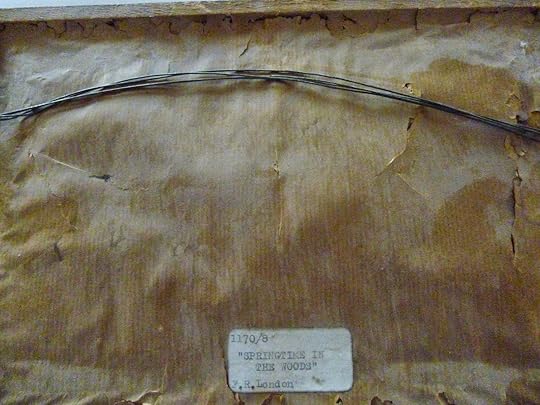
Even the way I wrote that ‘has found themselves’. … How did they get there? The floor is covered in bluebells so it is spring and the trees are green but goodness knows how awful it would be in the winter. There is a sense of contented isolation about it and I’m sure this picture was in my mind when I wrote about the isolated cottage in Blood of Crows. But the picture asks a lot of questions. Who lives in that wee cottage? Why do they live in such a remote place? If you were brutally murdered there, would any body hear you scream. Would anybody find you if you were buried in amongst the bluebells? Forensic topography would mean nothing here. A mobile phone will not work here. You will be at the mercy of the spirits of the forest and the wood elves.And the biggest question of all, if my granny liked it so much, why isn’t it in a nicer frame? There is something of fairytale darkness about it, of Hansel and Gretel, and the Little Red Riding Hood. It is Grimm, if you pardon the pun.I keep coming back to the isolation, the sense that you are on your own and you will either rise or fall but it will be by your own hand.

My gran, the owner of the picture, was orphaned as she was born, the youngest of 13 children and grew up in an orphanage. With her closest sisters, they lived together as a unit, with a house mother in a ‘small cottage’ somewhere outside Sheffield. There they learned to cook and sew and clean with a view to going into service. She dreamed of being a seamstress, always darned everything. I mean everything.

She never said a bad word about the orphanage, the ‘cottage homes’ as the system was called. They had food in their bellies and many folk didn’t in the north of England in those days ( we are talking early 1900 here). She grew up being terrified of ending up in the workhouse (which was what the Southern General of last week’s post was originally built for.) and while researching some pictures for the blog I realised why; the workhouses and the cottage homes were both part of the action on poverty at that time. So the home was not just for orphans, but for children whose families could no longer afford to keep them.
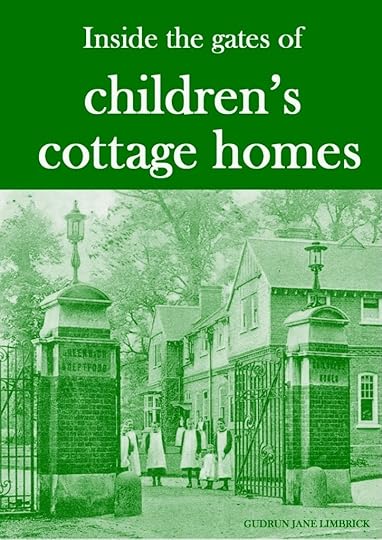
And it was a label of social disgrace. But Yorkshire girls are tough and I don’t think my gran ever noticed or if she did, she didn’t care. The only thing I heard her comment on occasionally, was the cruelty of the local village children to the cottage home children. They would bully and taunt the orphanage kids. It was a five mile walk, over rough ground, often in snow, from the orphanage to the school. The cottage children wore leather boots all year round. The boots were good quality and handed over from child to child as the foot size changed, to cope with the long walk to lessons – and the boots were the badge of ‘being different’ was how she put it.
All her life she stood up for the underdog and taking this literally, would come home with unwanted puppies and stray dogs with bits missing. She had a difficult life, moving to Glasgow to live in a Govan tenement over run with mice, being widowed and left with three children but she never lost her ‘we never died a winter yet’ attitude. Don’t get me wrong, she wasn’t a sweet nice little granny, she was more your functional granny. She was a strict disciplinarian and would bruise my knuckles by rapping them with a wooden spoon, when I misbehaved at the tea table.
Which was often.
At thirteen, the girls had to leave the cottage home to go out to work and in her first week of being a junior housemaid, she was crossing a road, avoiding a young man cutting a hedge. He took one look and said to her, ‘Are you Jessie Cadwallander’. It was one of her older brothers and the whole family slowly got back together again.

Only to be ripped apart by two world wars.She was never one for looking back. She died at 105 without a bit of dementia, and apart from sight loss and hearing issues, she was in good health. It said on her death certificate ‘extreme old age’. And that canny be a bad thing.
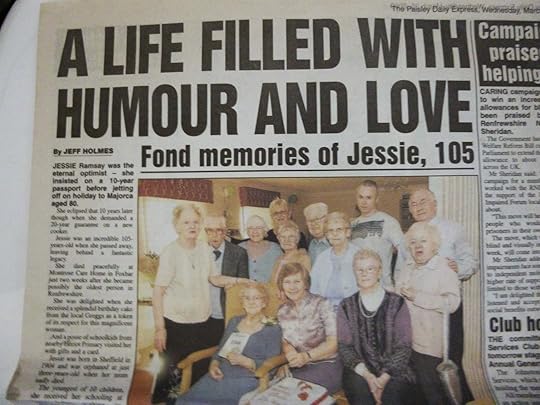
Her secret to a long life? She didn’t drink ( one advocaat at Christmas and even then she couldn’t finish it as it was too strong). She always had a four legged companion somewhere. She worked hard (still in the community canteen in her seventies). She had, because of poverty, what we would call a good diet. She was green fingered and grew everything. Red meat was a rare thing. She ate fish, porridge and every morning started with a glass of water with a lemon squeezed into it. Her number one tip, be content with your own company. She was never ever lonely although she had few friends and lived on her own for the last fifty years of her life. Which brings us back to the picture, and the isolation of that house, and the carpet of bluebells. And where do I live now? In a house across the road from the woods that are known on the map as the bluebell woods. Every morning the dog and I go up there to be on our own. We don’t need company so we walk up on the high ground away from the handbag dogs and anything that ends with ‘doodle.’ I think it might be in the genes.
Caro Ramsay
 The Three Kings by Susan Crawford
The Three Kings by Susan CrawfordMy favourite picture of all is a tiny print in a simple wood frame with a typed label on the back. It hung over my granny’s sideboard for many years. It has been a constant in my life, a feeling that I want to live in that house down this lane.My granny too said it was her favourite picture. Yet it is so small, so unprepossessing, with no mount around it, no fancy frame. It’s held together by a bit of string. It’s not even a painting. It’s not even very good. The brown paper on the back looks as though it came from a paper bag and it is crumpled, torn and repeatedly stained with watermarks from the floods when my granny’s neighbours upstairs left their bath running.
 Only 10 " by 8",
Only 10 " by 8", But the picture is beguiling. Enchanting.I’m not sure if the picture is one of extreme calm or imminent threat. There is no light coming through the tree canopy, it’s all dark. There is a single winding path that is waterlogged leading up to a tiny cottage that may or may not have a thatched roof. The path seems to wind its way beyond the cottage into the only area of light so the viewer’s eye is taken from the darkness and into the light. From that point of view, the viewer has found themselves in the middle of the forest and faces a long walk to get out.

Even the way I wrote that ‘has found themselves’. … How did they get there? The floor is covered in bluebells so it is spring and the trees are green but goodness knows how awful it would be in the winter. There is a sense of contented isolation about it and I’m sure this picture was in my mind when I wrote about the isolated cottage in Blood of Crows. But the picture asks a lot of questions. Who lives in that wee cottage? Why do they live in such a remote place? If you were brutally murdered there, would any body hear you scream. Would anybody find you if you were buried in amongst the bluebells? Forensic topography would mean nothing here. A mobile phone will not work here. You will be at the mercy of the spirits of the forest and the wood elves.And the biggest question of all, if my granny liked it so much, why isn’t it in a nicer frame? There is something of fairytale darkness about it, of Hansel and Gretel, and the Little Red Riding Hood. It is Grimm, if you pardon the pun.I keep coming back to the isolation, the sense that you are on your own and you will either rise or fall but it will be by your own hand.

My gran, the owner of the picture, was orphaned as she was born, the youngest of 13 children and grew up in an orphanage. With her closest sisters, they lived together as a unit, with a house mother in a ‘small cottage’ somewhere outside Sheffield. There they learned to cook and sew and clean with a view to going into service. She dreamed of being a seamstress, always darned everything. I mean everything.

She never said a bad word about the orphanage, the ‘cottage homes’ as the system was called. They had food in their bellies and many folk didn’t in the north of England in those days ( we are talking early 1900 here). She grew up being terrified of ending up in the workhouse (which was what the Southern General of last week’s post was originally built for.) and while researching some pictures for the blog I realised why; the workhouses and the cottage homes were both part of the action on poverty at that time. So the home was not just for orphans, but for children whose families could no longer afford to keep them.

And it was a label of social disgrace. But Yorkshire girls are tough and I don’t think my gran ever noticed or if she did, she didn’t care. The only thing I heard her comment on occasionally, was the cruelty of the local village children to the cottage home children. They would bully and taunt the orphanage kids. It was a five mile walk, over rough ground, often in snow, from the orphanage to the school. The cottage children wore leather boots all year round. The boots were good quality and handed over from child to child as the foot size changed, to cope with the long walk to lessons – and the boots were the badge of ‘being different’ was how she put it.
All her life she stood up for the underdog and taking this literally, would come home with unwanted puppies and stray dogs with bits missing. She had a difficult life, moving to Glasgow to live in a Govan tenement over run with mice, being widowed and left with three children but she never lost her ‘we never died a winter yet’ attitude. Don’t get me wrong, she wasn’t a sweet nice little granny, she was more your functional granny. She was a strict disciplinarian and would bruise my knuckles by rapping them with a wooden spoon, when I misbehaved at the tea table.
Which was often.
At thirteen, the girls had to leave the cottage home to go out to work and in her first week of being a junior housemaid, she was crossing a road, avoiding a young man cutting a hedge. He took one look and said to her, ‘Are you Jessie Cadwallander’. It was one of her older brothers and the whole family slowly got back together again.

Only to be ripped apart by two world wars.She was never one for looking back. She died at 105 without a bit of dementia, and apart from sight loss and hearing issues, she was in good health. It said on her death certificate ‘extreme old age’. And that canny be a bad thing.

Her secret to a long life? She didn’t drink ( one advocaat at Christmas and even then she couldn’t finish it as it was too strong). She always had a four legged companion somewhere. She worked hard (still in the community canteen in her seventies). She had, because of poverty, what we would call a good diet. She was green fingered and grew everything. Red meat was a rare thing. She ate fish, porridge and every morning started with a glass of water with a lemon squeezed into it. Her number one tip, be content with your own company. She was never ever lonely although she had few friends and lived on her own for the last fifty years of her life. Which brings us back to the picture, and the isolation of that house, and the carpet of bluebells. And where do I live now? In a house across the road from the woods that are known on the map as the bluebell woods. Every morning the dog and I go up there to be on our own. We don’t need company so we walk up on the high ground away from the handbag dogs and anything that ends with ‘doodle.’ I think it might be in the genes.
Caro Ramsay
Published on April 29, 2015 01:04
April 19, 2015
The Southern General....
We are in the throws of the undignified name calling and ludicrous argument that passes for political debate over here. It will go on until May 7th when various reprobates will think they run the country. And hopefully keep out the way of those that actually do.
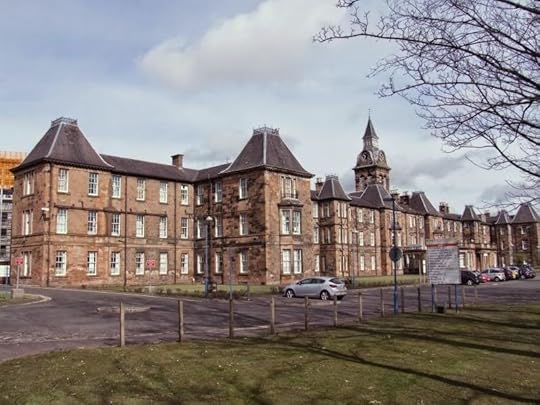
The hospital is being transferred from this to this..
 The Death Star
The Death Star
Some things are too important to be in the hands of politicians. I think Gordon Brown thought that about interest rates and handed them over to the Bank of England.
The NHS is a popular football for the various political parties to kick around while most of us believe that it is too valuable to be in the hands of any political party.

The helicopter landing pad
I have always suffered from migraine but since February they have changed character. From the 'go away and leave me alone while my head feels like it is being skewered so I want to lie still and watch the kaleidoscope on my eyelids' type of migraine, to something much. much worse. Rolling on the floor, banging my head off the tiles, pulling hair out type of pain. Short lived, but brutal.
Even I reckoned this was not normal.
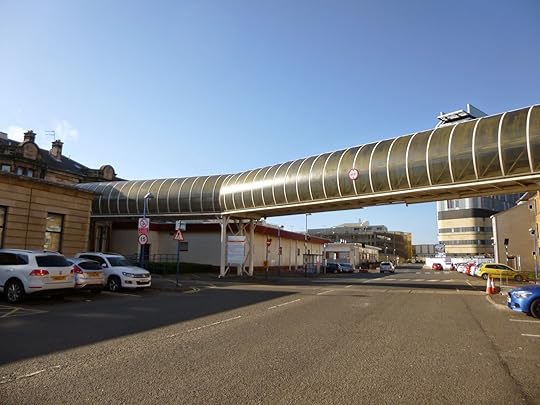
new meets old or vice versa
Went to Gp and got stuff to stick up my nose as soon as the headache starts. This medicine works very well but gave no clue as to what was causing the pain. He diagnosed cluster headache, often called the suicide headache because it is that painful. I am lucky that, with me, the pain is there and gone within thirty minutes and (so far) it is always in the small hours of the morning. But I can’t imagine living with that pain four or five times a day. If a patient does, the current treatment of choice is a having a brain stimulator surgically placed in the deep part in the brain to derail the signals.

Fancy car park. With no spaces.
The only problem was my cluster headache is not in the part of the head that gives cluster headache. So the GP referred me for a neurological appointment at the Southern General Hospital, known by locals as the Suffering General. He said it was not urgent, the appointment may take a while to come through. The subtext of that ( and what the political debate is always about) is that the waiting list is a bit long at the moment. But just to make it clear, if you really need it, it will get done and the NHS will do it quickly. But if you can wait – you wait. Neurology is always busy as for some of their patients, waiting is a matter of life and death. Mine wasn’t, Mine was just sore. So a routine appointment was requested and came through within two weeks. On a Sunday. Subtext, so busy they were doing Sunday clearance clinics. I had a thorough consultation with a neurologist who was very nice and very engaging. What did I think? What did she think? What did I think of what she thought? Why can I not have cluster headache in the same place as everybody else? Because it might not be cluster headache.
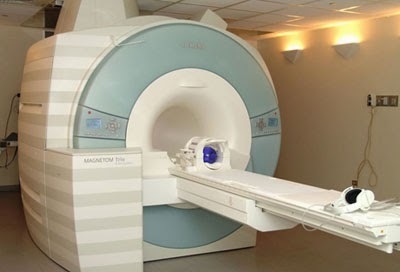 She recommended two MRI scans - brain and neck. Not urgent. The appointment for the scan came through two days later. Eight o’clock in the morning.
She recommended two MRI scans - brain and neck. Not urgent. The appointment for the scan came through two days later. Eight o’clock in the morning.
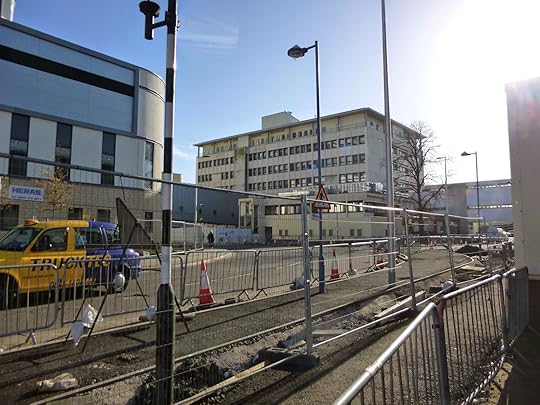
Nice quiet surroundings for the patients
And that was this morning.
By now, the neurologist and I had been thinking about Arnold Chiari malformation which means the bone at the top of the spine is a bit wonky so bits of the brain start to slid down the spinal canal. As you can imagine, that is a wee tad sore.

This hurts!
But I am consoled that it only happens to folk with big brains. That is not really true but it’s my blog so I can say what I like.
It used to be thought of as a fatal condition but as scanning gets better it has been realised that a few folk are walking about with various versions in various degrees of malformation with no symptoms what so ever. Until something else annoys it. Like an old spinal fracture. Like mine.

Where exactly do we walk?
And when the neurologist read about that, her little face lit up in a true light bulb moment. That is now coming back to haunt you, she said with something approaching glee. I was still with the theory of big brain in a wee head.
The Southern General is a big Glasgow Hospital, right on the side of the Clyde at Govan. It is slowly being rebuilt into a super hospital called the ‘death star’. It has become a local talking point as it has been built with very little regard to patients.And the fact that patients need transport.And maybe need somewhere to park their car.

Driving around the Southern General building site for an hour and a half to get a parking place is common. Locals now need permits which they have to pay for, to park their own cars in the streets outside their own house. Promises of free buses, and patient transport have not yet come to fruition. The radiologist who dealt with me parks in the garden centre a mile and a half away and walks it from there.
The hospital/ building site is about fifteen minutes drive from my house so I left at six thirty am for my eight am scan and got the last parking space available on the first drive round. I sat in the car waiting and writing the next book while the builders in front of me kept taking their clothes on and off like some geriatric Coca Cola advert. I don’t know what they were wearing underneath their t shirts, but it needed ironing. The old jokes are the best.
 The old hospital was based in a Victorian Workhouse. If there was a fire, patients had to be strapped to their mattresses and bounced down the stairs. The hospital then had big wards, a stern matron, no MRSA, no talking back and stank of Dettol and boiled sprouts.
The old hospital was based in a Victorian Workhouse. If there was a fire, patients had to be strapped to their mattresses and bounced down the stairs. The hospital then had big wards, a stern matron, no MRSA, no talking back and stank of Dettol and boiled sprouts.
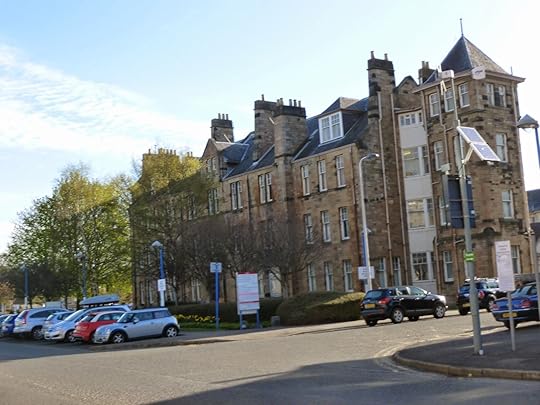 Now the whole scene is weird; builders everywhere, trucks, diggers, cement mixers, people walking around confused and lost, taxis doing u-turns, wheelchair users bumping up curbs, patients running from A to B, then B to A, posters telling folk where to go ( the posters have been drawn over as a new building was added or opened or closed ). There are over head tunnels temporarily connecting bits X to Z as Y has not been built yet. To get to the scanner, I had to walk for about twenty minutes from my car, into a reception, upstairs, along a corridor, through a kitchen ( so it seemed), passed a few disused lift shafts, all the time following a series of printed out signs sellotaped on the wall, over tunnels, under ground until I bounced almost by accident into the MRI scanning reception. After the scan , the nurse took me by the hand, across the hall, into an office, over some boxes and out a side door, and lo and behold, there was my car.
Now the whole scene is weird; builders everywhere, trucks, diggers, cement mixers, people walking around confused and lost, taxis doing u-turns, wheelchair users bumping up curbs, patients running from A to B, then B to A, posters telling folk where to go ( the posters have been drawn over as a new building was added or opened or closed ). There are over head tunnels temporarily connecting bits X to Z as Y has not been built yet. To get to the scanner, I had to walk for about twenty minutes from my car, into a reception, upstairs, along a corridor, through a kitchen ( so it seemed), passed a few disused lift shafts, all the time following a series of printed out signs sellotaped on the wall, over tunnels, under ground until I bounced almost by accident into the MRI scanning reception. After the scan , the nurse took me by the hand, across the hall, into an office, over some boxes and out a side door, and lo and behold, there was my car.
Once the superhospital is finished, there will be rest stops, sherpas and Sat Navs.
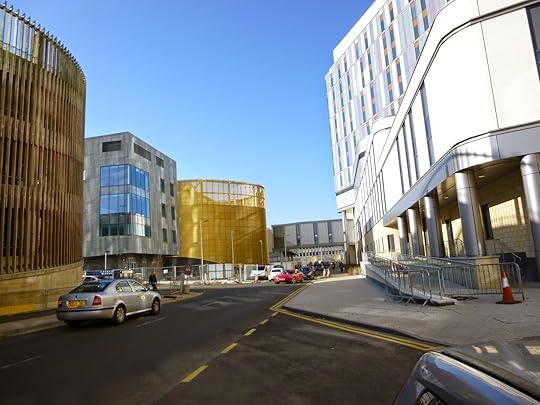 So the scanner has not been moved to the new bit yet so the waiting area was well worn, battle scarred and depressing. But it was spotlessly clean and the service was second to none. So what if the gowns looked as though they have been washed to within an inch of their existence, the bit of the service that actually saves lives was running like a well oiled machine.
So the scanner has not been moved to the new bit yet so the waiting area was well worn, battle scarred and depressing. But it was spotlessly clean and the service was second to none. So what if the gowns looked as though they have been washed to within an inch of their existence, the bit of the service that actually saves lives was running like a well oiled machine.
I was aware of the comedic drama the other patient - some old guy who had been hauled in off the street outside for his scan as he was having a last minute fag, and wouldn’t come in until he had finished. I bet he was having a scan for a growth in his lung. He was round; five feet five in every direction and too breathless to undress himself. And the nurses were great with him, humorous and cajoling but taking no nonsense.

Fried egg roll, black coffee and notebook!
After a hour of being zapped and blasted, I climbed into the small Fiat and drove round (and round and round) to the garden centre…. Just to chill before going back home on the motorway.

goodies at the garden centre....

These are the size of one of small asteroid.
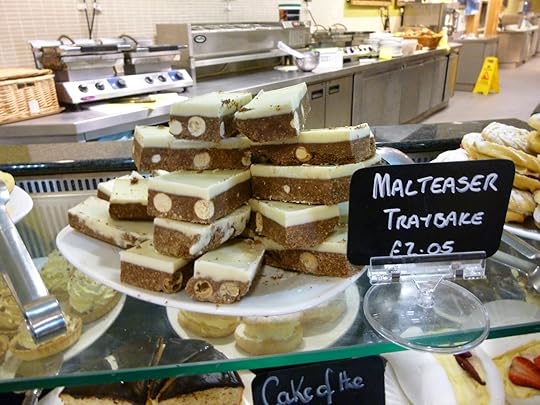


And did some more writing...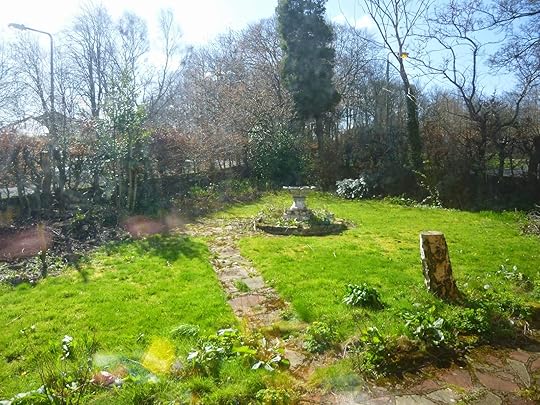
The view out my writing room window!
Caro Ramsay 17 04 2015

The hospital is being transferred from this to this..
 The Death Star
The Death StarSome things are too important to be in the hands of politicians. I think Gordon Brown thought that about interest rates and handed them over to the Bank of England.
The NHS is a popular football for the various political parties to kick around while most of us believe that it is too valuable to be in the hands of any political party.

The helicopter landing pad
I have always suffered from migraine but since February they have changed character. From the 'go away and leave me alone while my head feels like it is being skewered so I want to lie still and watch the kaleidoscope on my eyelids' type of migraine, to something much. much worse. Rolling on the floor, banging my head off the tiles, pulling hair out type of pain. Short lived, but brutal.
Even I reckoned this was not normal.

new meets old or vice versa
Went to Gp and got stuff to stick up my nose as soon as the headache starts. This medicine works very well but gave no clue as to what was causing the pain. He diagnosed cluster headache, often called the suicide headache because it is that painful. I am lucky that, with me, the pain is there and gone within thirty minutes and (so far) it is always in the small hours of the morning. But I can’t imagine living with that pain four or five times a day. If a patient does, the current treatment of choice is a having a brain stimulator surgically placed in the deep part in the brain to derail the signals.

Fancy car park. With no spaces.
The only problem was my cluster headache is not in the part of the head that gives cluster headache. So the GP referred me for a neurological appointment at the Southern General Hospital, known by locals as the Suffering General. He said it was not urgent, the appointment may take a while to come through. The subtext of that ( and what the political debate is always about) is that the waiting list is a bit long at the moment. But just to make it clear, if you really need it, it will get done and the NHS will do it quickly. But if you can wait – you wait. Neurology is always busy as for some of their patients, waiting is a matter of life and death. Mine wasn’t, Mine was just sore. So a routine appointment was requested and came through within two weeks. On a Sunday. Subtext, so busy they were doing Sunday clearance clinics. I had a thorough consultation with a neurologist who was very nice and very engaging. What did I think? What did she think? What did I think of what she thought? Why can I not have cluster headache in the same place as everybody else? Because it might not be cluster headache.
 She recommended two MRI scans - brain and neck. Not urgent. The appointment for the scan came through two days later. Eight o’clock in the morning.
She recommended two MRI scans - brain and neck. Not urgent. The appointment for the scan came through two days later. Eight o’clock in the morning.
Nice quiet surroundings for the patients
And that was this morning.
By now, the neurologist and I had been thinking about Arnold Chiari malformation which means the bone at the top of the spine is a bit wonky so bits of the brain start to slid down the spinal canal. As you can imagine, that is a wee tad sore.

This hurts!
But I am consoled that it only happens to folk with big brains. That is not really true but it’s my blog so I can say what I like.
It used to be thought of as a fatal condition but as scanning gets better it has been realised that a few folk are walking about with various versions in various degrees of malformation with no symptoms what so ever. Until something else annoys it. Like an old spinal fracture. Like mine.

Where exactly do we walk?
And when the neurologist read about that, her little face lit up in a true light bulb moment. That is now coming back to haunt you, she said with something approaching glee. I was still with the theory of big brain in a wee head.
The Southern General is a big Glasgow Hospital, right on the side of the Clyde at Govan. It is slowly being rebuilt into a super hospital called the ‘death star’. It has become a local talking point as it has been built with very little regard to patients.And the fact that patients need transport.And maybe need somewhere to park their car.

Driving around the Southern General building site for an hour and a half to get a parking place is common. Locals now need permits which they have to pay for, to park their own cars in the streets outside their own house. Promises of free buses, and patient transport have not yet come to fruition. The radiologist who dealt with me parks in the garden centre a mile and a half away and walks it from there.
The hospital/ building site is about fifteen minutes drive from my house so I left at six thirty am for my eight am scan and got the last parking space available on the first drive round. I sat in the car waiting and writing the next book while the builders in front of me kept taking their clothes on and off like some geriatric Coca Cola advert. I don’t know what they were wearing underneath their t shirts, but it needed ironing. The old jokes are the best.
 The old hospital was based in a Victorian Workhouse. If there was a fire, patients had to be strapped to their mattresses and bounced down the stairs. The hospital then had big wards, a stern matron, no MRSA, no talking back and stank of Dettol and boiled sprouts.
The old hospital was based in a Victorian Workhouse. If there was a fire, patients had to be strapped to their mattresses and bounced down the stairs. The hospital then had big wards, a stern matron, no MRSA, no talking back and stank of Dettol and boiled sprouts. Now the whole scene is weird; builders everywhere, trucks, diggers, cement mixers, people walking around confused and lost, taxis doing u-turns, wheelchair users bumping up curbs, patients running from A to B, then B to A, posters telling folk where to go ( the posters have been drawn over as a new building was added or opened or closed ). There are over head tunnels temporarily connecting bits X to Z as Y has not been built yet. To get to the scanner, I had to walk for about twenty minutes from my car, into a reception, upstairs, along a corridor, through a kitchen ( so it seemed), passed a few disused lift shafts, all the time following a series of printed out signs sellotaped on the wall, over tunnels, under ground until I bounced almost by accident into the MRI scanning reception. After the scan , the nurse took me by the hand, across the hall, into an office, over some boxes and out a side door, and lo and behold, there was my car.
Now the whole scene is weird; builders everywhere, trucks, diggers, cement mixers, people walking around confused and lost, taxis doing u-turns, wheelchair users bumping up curbs, patients running from A to B, then B to A, posters telling folk where to go ( the posters have been drawn over as a new building was added or opened or closed ). There are over head tunnels temporarily connecting bits X to Z as Y has not been built yet. To get to the scanner, I had to walk for about twenty minutes from my car, into a reception, upstairs, along a corridor, through a kitchen ( so it seemed), passed a few disused lift shafts, all the time following a series of printed out signs sellotaped on the wall, over tunnels, under ground until I bounced almost by accident into the MRI scanning reception. After the scan , the nurse took me by the hand, across the hall, into an office, over some boxes and out a side door, and lo and behold, there was my car.Once the superhospital is finished, there will be rest stops, sherpas and Sat Navs.
 So the scanner has not been moved to the new bit yet so the waiting area was well worn, battle scarred and depressing. But it was spotlessly clean and the service was second to none. So what if the gowns looked as though they have been washed to within an inch of their existence, the bit of the service that actually saves lives was running like a well oiled machine.
So the scanner has not been moved to the new bit yet so the waiting area was well worn, battle scarred and depressing. But it was spotlessly clean and the service was second to none. So what if the gowns looked as though they have been washed to within an inch of their existence, the bit of the service that actually saves lives was running like a well oiled machine.I was aware of the comedic drama the other patient - some old guy who had been hauled in off the street outside for his scan as he was having a last minute fag, and wouldn’t come in until he had finished. I bet he was having a scan for a growth in his lung. He was round; five feet five in every direction and too breathless to undress himself. And the nurses were great with him, humorous and cajoling but taking no nonsense.

Fried egg roll, black coffee and notebook!
After a hour of being zapped and blasted, I climbed into the small Fiat and drove round (and round and round) to the garden centre…. Just to chill before going back home on the motorway.

goodies at the garden centre....

These are the size of one of small asteroid.



And did some more writing...

The view out my writing room window!
Caro Ramsay 17 04 2015
Published on April 19, 2015 10:41
April 12, 2015
The law is an ar!!

The British Legal system only began to update in 1965 and the squabbles between the various parts of the union over the years have left some interesting laws in its wake.
It is illegal to die in the Houses of Parliament. If you did you would be entitled to a state funeral as you would be a charge of the Royal Coroner. It is also illegal to enter Parliament wearing a suit of armour… in case you are going to start something and think you might need it.
It is legal to shoot a Scotsman within the city walls of York. If he is carrying a bow and arrow. But not on a Sunday. Scotswomen are not mentioned.

In Scotland, it is illegal for a boy under the age of 10 to see a naked mannequin.
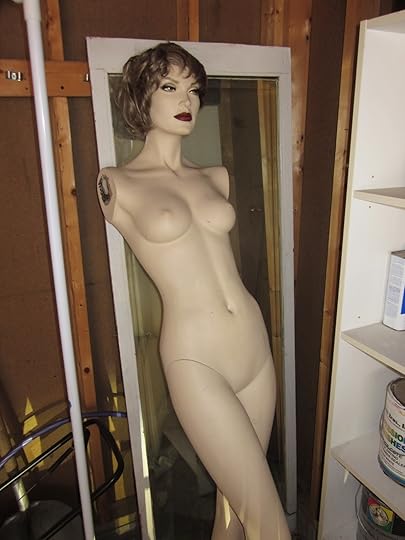
Cue joke about her being 'armless..'
In Scotland the law obliges citizens to allow whoever knocks on their door to use their toilet. This is a variation of the trespass law and it is often thought (indeed I have said it on this blog site) that there is no law of trespass in Scotland. There is, technically, but the word trespass refers to camping, inhabiting or doing injury to the ground. So we have the right to wander where we like as long as we do no damage. The law obviously comes from the fact that a lot of Scotland is empty and it was useful to go from A to B, over the land of other clans, without going the long way round to ask permission.
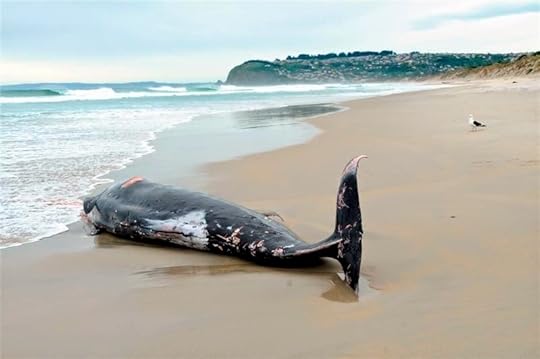
The head of any dead whale found on the Scottish coast automatically becomes the property of the king. And the tail becomes property of the queen. (Sturgeons also!). And any mute swan living in open water belongs to the monarch ( so I think you can be shot for killing them.) In reality, you are supposed to tell the Natural HIstory museum about any whales washed up on shore which could be bad news for Dippy.
Any Scotsman found to be wearing underwear beneath his kilt can be fined two cans of beer. This is internet nonsense. No Scotsman would pay such a fine.
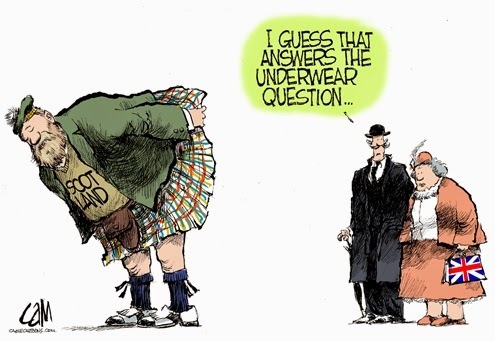 It is illegal in Scotland to be drunk and in charge of a cow. As there are a lot of cows and a lot of drink this is true. It is also the law that being drunk in charge of a motorbility scooter is charged under.
It is illegal in Scotland to be drunk and in charge of a cow. As there are a lot of cows and a lot of drink this is true. It is also the law that being drunk in charge of a motorbility scooter is charged under.In Carlisle, any Scot found wandering around may be whipped or jailed. I was taking my life in my hands at Crime and Publishment! This law is a remnant from 1157 or thereabouts.
It is an act of treason to place a postage stamp bearing the British monarch upside-down, presumably her crown might falloff

Mince pies cannot be eaten on Christmas Day in England. I remember reading somewhere that this was Oliver Cromwell’s fault.
In the UK a pregnant woman can legally relieve herself anywhere she wants, including in a policeman's helmet.
It is still an offence to beat or shake any carpet rug or mat in any street in the Metropolitan Police District, although you are allowed to shake a doormat before 8am. You crimey types probably know that there is the Met police and the City of London police- they are two distinct forces. The City is a tiny part right in the middle of London. PD James wanted to lie a body right where the boundary lay to see what force would deal with the murder and was told that it was the position of the corpse head that counted. ( A Certain Justice.)
It is illegal to keep a pigsty in front of your house. My entire house mid novel, resembles a pig sty.
It is illegal to order or permit any servant to stand on the sill of any window to clean or paint it.Under the Metropolitan Police Act 1839 no person (other than persons acting in obedience to lawful authority) is to discharge any cannon or other firearm of greater calibre than a common fowling-piece within 300 yards of any dwelling house to the annoyance of any inhabitant thereof.
It is illegal to use a television in Britain without a license. Even if you only watch the TV programme on a computer, you must still hold a licence.
Under the terms of the Protection of Wrecks Order 2003: A person shall not enter the hull of the Titanic without permission from the Secretary of State.
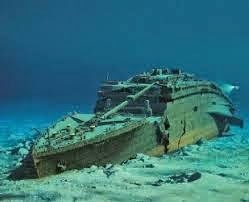 It is also an offence to activate your burglar alarm and leave your property if you haven't nominated a key-holder who can access your house to silence it should it go off. This is a fairly recent addition to British law and was established under the terms of the Clean Neighbourhoods and Environment Act – 2005.
It is also an offence to activate your burglar alarm and leave your property if you haven't nominated a key-holder who can access your house to silence it should it go off. This is a fairly recent addition to British law and was established under the terms of the Clean Neighbourhoods and Environment Act – 2005. A horn should only be used when warning someone of danger, not to indicate your annoyance at a manner of driving ... whether or not the car is parked!!
In London, it is illegal for a person (knowingly) with the plague to flag down a taxi or try and ride on a bus. It is illegal for a cab in the City of London to carry rabid dogs or corpses. And when I did my training, we were warned not to take our training skeletons (which were real) on London public transport.
It is illegal under the terms of the Prohibition and Inspections Act of 1998 to cause a nuclear explosion. Well ... that's a pretty good idea! But ... why it had to be a special law though is a mystery...
And…In Ohio, it is illegal to get a fish drunkIn Alabama, it is illegal to be blindfolded while driving a vehicle.Florida, unmarried women who parachute on a Sunday could be jailed.In Vermont, women must obtain written permission from their husbands to wear false teeth.In France, it is illegal to name a pig Napoleon.
Caro
Published on April 12, 2015 11:07
March 23, 2015
The Babes In The Wood Murders

The fourth of February 1990 was a cold, sunny day. The kind of day where a good walk blows away the cobwebs. A couple were out for a stroll, on a beauty spot called the Devil's Dyke on the Sussex Downs. This is England’s green and rolling land. No doubt Susan and David Clifton were enjoying the views in the late winter sunshine when a small girl came stumbling towards them, emerging from the bushes with her clothes hanging from her, nearly torn off. She was bleeding from scratches all over her arms and legs and around her throat where there were tell-tale bruises of attempted strangulation.She was seven years old.And very lucky to be alive.
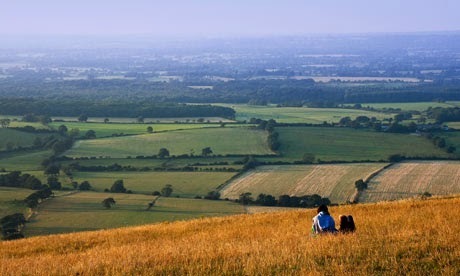 Sussex
SussexShe had very nearly been strangled by a technique taught to the SAS, known as The Sleeper. It is a particular hold that compresses the carotid artery, cutting off the blood supply to the brain. Unconsciousness comes quickly, death follows in three to five minutes.
The girl had a horrific story to tell. After her family Sunday lunch, she had put on her new roller skates and went out to play in the estate where she lived in Brighton. She was skating along the pavement and saw a red car with its boot open. She thought little more about it and skated closer. As she tried to pass the car the man got out.And showed her a screw driver. He said four words to her. Scream and I’ll kill you.
He then put her in the boot, drove her to the Devil's Dyke and took her out the boot. He strangled her until her body went limp, then put her in the back of his car and sexually assaulted her.Convinced she was dead, he dumped her body in the bushes and drove off.
She was a brave, clever little girl, never named for obvious reasons) and she was able to give the police a very good description of the man, and his car – a red ford Cortina. She was also covered in forensic evidence.It all pointed clearly to one man - Russell Bishop.
 Bishop
BishopAt the trial, he was convicted of abduction, kidnap and attempted murder and got a life sentence.
Three years before, he had stood in the same dock and been acquitted of the murders of two little girls, Nicola Fellows and Karen Hadaway. It became famous as the 'babes in the wood case'.The two cases are very similar.
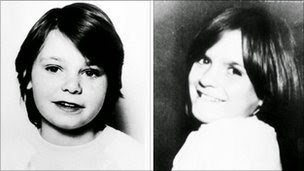 The famous Babes In The Wood Photograph
The famous Babes In The Wood PhotographNicola and Karen had been playing round the estate where they lived, in Brighton. They were seen buying chips from the local chippie at about half past six. The next day, at twenty past four, during a massive search by police and local residents, two small bodies were found in the dense undergrowth, deep in the bushes. They had died with their arms round each other. The pathologist, the same pathologist who picked up the sleeper marks on the other girl three years later, suggested that both girls had been strangled and sexually assaulted.
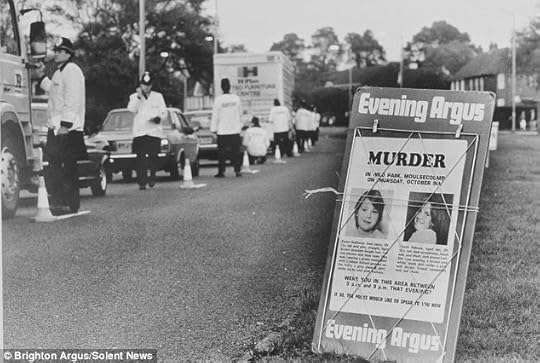
An unemployed labourer, in his twenties had lived on the same estate as the girls, he had known them both and their families; he played football and cricket with their dad. Although he had a history of petty thieving, he was living quietly at the time with his partner and their child.
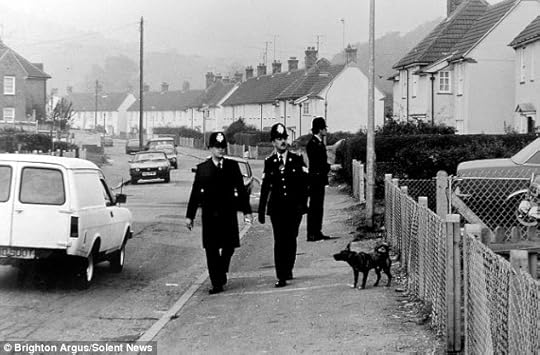
The evidence presented at the trial against him was some specks of blood on a jumper that other witnesses said belonged to him and the fact that the jumper had been found on his most likely route home. Some fibres on that jumper matched fibres from the clothes worn by Karen and Nicola when they had gone out that day.
 His defence was that he was one of the first people on the scene when the girls were found. He argued as he had taken their pulses, any exchange of trace evidence could be accounted for.
His defence was that he was one of the first people on the scene when the girls were found. He argued as he had taken their pulses, any exchange of trace evidence could be accounted for.It took the jury less than two hours to find him not guilty. But with hindsight, as soon as the law changed, the police saw the chance to review the Babes In The Wood case.

In 2005-6 new legislation came in in England to release the Crown Prosecution Office from double jeopardy If new evidence has come to light. Brighton police tried but could not find enough evidence to press for a new prosecution for the first two victims.
He was eligible for parole last year and it was turned down.

Interestingly, the police had always had an eye on Nicola’s dad Barrie. He had been questioned before Bishop’s arrest and there was some local feeling that he might have been involved in some way. His house was daubed with paint and as he moved house, so did the malicious vandalism – the message was always the same. Don’t let the murderer live here.
Then in April 2009, Barrie was arrested on suspicion of conspiring to rape his own daughter before her death, but that was based on false allegations that the police later claimed as malicious.
In a strange twist, the girl who played Nicola in a UK prime time TV reconstruction of the babes in the woods murders, was then also murdered, found stabbed in a graveyard in 1996. Her killing also remains unsolved.
Truth can indeed be stranger than fiction.
Caro Ramsay
Published on March 23, 2015 01:16
March 4, 2015
The sad story of Mikaeel Kular

A happy wee boy, always smiling
At about 9pm on Wednesday January 15th last year, a three year old boy, Mikaeel Kular was last seen in the house he shared with his mother and four siblings in Edinburgh. He was going to his bed dressed in his PJ’s.

By 7.15 the next morning the temperature had dropped to 2.3 degrees outside. Rosdeep Kular, the boy’s mother, made the terrible discovery that he was missing from his bed. She found a stool pulled over to the front door and deduced that he had climbed up to reach the lock to get out.
Two hours later a massive police search was under way. Neighbours heard about Mikaeel and came out to help. A helicopter was scrambled as the police released a picture of the boy with a description of what he might be wearing. It touches the heart, an innocent faced Asian featured boy, with a big smile. He is said to be wearing a beige hooded jacket, brown shoes and blue joggers over his pyjamas.

This picture makes every TV news, the late editions of the papers carry it on their front page. People talk, as people do. The Mum’s marriage was in trouble. Maybe the Dad had taken the boy? How many three year olds can dress themselves? Do their own shoes up? How many are strong enough to open the heavy fireproof front doors on a modern house?

An hour after that image is released, the police make a statement that there is no suspicion of foul play but they are keeping an open mind. The mother is said to be distraught. Neighbours of the family are asked to search huts and garages, just in case Mikaeel has taken shelter from the weather and got locked in.
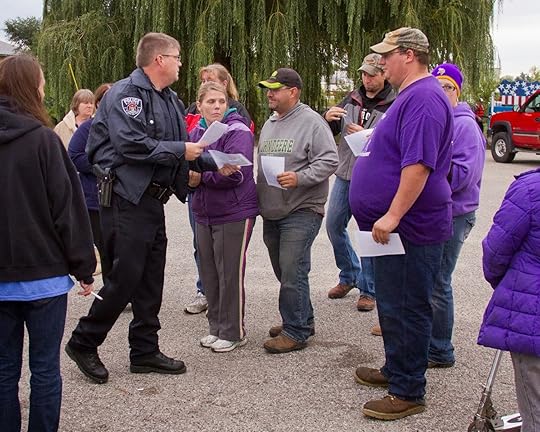
That afternoon coastguard and lifeboats search the coast. A Child Rescue Alert is initiated so all police forces in the UK are now involved. This allows TV and radio programmes to be interrupted with news flashes. Statements are made in parliament, hoping for a safe return of the child. The police refuse to comment on ‘local intelligence’ that there was a custody issue about the boy.
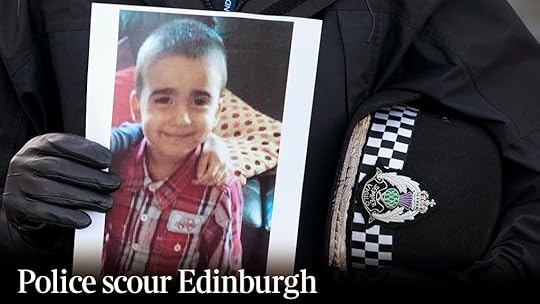
As darkness falls again, more neighbours, the entire community, all emergency services are out looking for the boy as the temperature drops well below freezing. It is now a matter of extreme concern. The search goes on all night.By nine the next morning, the police issue an updated image, showing what he was wearing when he disappeared.
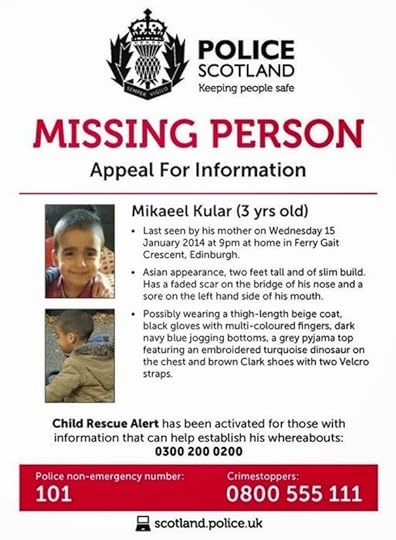
By first light the public, the police and all support services, police dogs, horses are all out searching. Family dogs are asked to help. There are over 150 calls to the helpline but no confirmed sightings. By mid morning, one hundred people are organised into a specific search. Mikaeel's image is prepared to go on billboards and train stations across the country. Meanwhile on Cramond Shore more volunteers, firemen and mothers with prams search the sand and rocks.
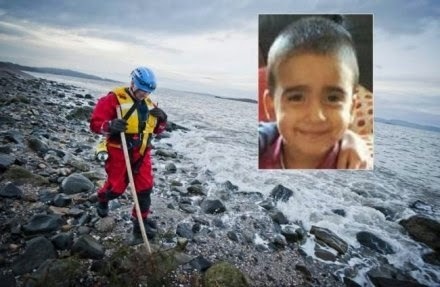 By late afternoon the Assistant Chief Constable announces that they are now exploring a theory that Mikaeel might have left the flat of his own free will after he became the subject of a criminal act. And the general public were left to fill in the blanks.
By late afternoon the Assistant Chief Constable announces that they are now exploring a theory that Mikaeel might have left the flat of his own free will after he became the subject of a criminal act. And the general public were left to fill in the blanks.By tea time it became known that all family members had been traced and talked to. Mikaeel’s timeline was established. It showed that he hadn’t been to nursery since before Christmas because he had been ill. It was now January 17th. A forensic team was seen entering the boy’s house that night.Later that night the police thank everybody who has helped in the searches but say they will continue on their own. There is a sense that the investigation is now targeted and that there will be more announcements.
Just after midnight, on the morning of Saturday 18th January 2014, the police announce that they have found a body that maybe Mikaeel’s over 25 miles away in Kirkcaldy, fife. The family have been informed and somebody has been detained in connection with the incident.
That person was the boy’s mother, Rosdeep.
People are upset, flowers and toys are left outside his house and the property in Kirkcaldy. There is a genuine sense of shock. Even for those of us who didn’t really believe the first version of events. By four o’clock that afternoon, a small body is removed from woodland behind a house in Kirkcaldy. The house is owned by Rosdeep’s sister and Risdee and her five children lived there until 18 months before. One hour later, the police are granted another twelve hours to keep Rosdeep in custody.
At seven that night a candle light service is held for the boy, everybody attending holds a candle high in his memory. Four hours later, the body is officially confirmed as Mikaeel and his 33 year old mother is arrested and charged in connection with his disappearance. Later she is charged with his murder.
 His aunt Pandeep, Rosdeep's sister, was 'devastated' by her nephew's death as the forensic search of the wood behind her house continued.
His aunt Pandeep, Rosdeep's sister, was 'devastated' by her nephew's death as the forensic search of the wood behind her house continued. Two things emerged from the community involvement– a sense that they had come together. And a sense that their kindness had been abused.
Rosdeep Adekoya was sentenced to 11 years' imprisonment after she admitted killing the boy, wrapping him in a duvet, hiding his body in a suitcase and driving him 25 miles to dispose of the body in woodland she knew well – behind her sister’s house. In the three days prior to his death, he had received injuries bad enough to severely damage his internal organs.He had passed away on the evening of 14 January, probably from injuries inflicted the previous Sunday. The boy had been sick in a restaurant so she had beaten him with her fist, striking him about the body. He was then beaten while laid over the edge of the bath. She couldn’t take him to a doctor because of the bruising and his condition worsened. She found his body on the Tuesday morning, but had the sense of mind to drive his two sisters to nursery before driving his body to Fife.The pathologist found forty separate injuries to his body.The judge said her actions were "cruel and inexcusable".
So as crime writers we have gave to ask the question. Why?

Rosdeep’s remorse is ‘genuine and heartfelt" She was an intelligent, articulate woman with no history of violence to any of her children. She was in tears all the way through her sentencing appearance. In the end, unable to cope with the pressure, she told the police where to go and get his body.
She is a complex lady. Her parents were doctors, her Dad died relatively young. Her mother remarried another doctor. The family are wealthy members of the Asian community. Her five children have complicated parentage. She used to be very overweight, she got a gastric band and reinvented herself as a slim, chick about town. Before that there was a history of depression and, at least one suicide attempt. On social media sites she asked questions about why she loved all her children except one. Why was she so aggressive with only one of her children. And how do you get rid of bruises.
Mikaeel's father, who had already another partner and had other children by the time Mikaeel was killed, says that Rosdeep, Rosie as he called her, never got over their break up and resented the child because he looked so much like his father. That relationship was disapproved of by her family.Rosie, the ‘dancing queen’ became a social butterfly after her marriage broke down and it seems to me, she began to live life the way teenagers do. She hung about night clubs with friends of dubious character. Despite having five kids under the age of ten she set up her own beauty business then continued with her love of partying. Her facebook page was full of photos of her enjoying the night life. Including one friend who later died in a shooting incident.
The parents of her estranged husband always had reservations about her party lifestyle. Her husband tried to curb her behaviour, she objected so he left and believed that Rosie had moved on to another partner.
He divorced her on Christmas day 2014.
It seems a sad tale for all involved. Little Mikaeel paid with his life. A father has lost his son. His siblings will grow up knowing that their mother killed their brother. But you can’t help thinking that somewhere in there was a woman crying for help, or trying to be somebody she wasn’t. Trying to live a life that she thought she should have had.
Like I say, sad all round.
Caro
Published on March 04, 2015 13:52
February 20, 2015
Introducing Prince Axel
One of the best things about being a writer is MSU.
Making stuff up.
Did anybody read Susan's blog on Murder Is Everywhere last week and not think of a new Bond villain who sits and plots the downfall of western civilisation while watching the seahorses in his tank going about their own guerrilla tactics?
Or was that just me?
 I was wandering around the aquarium in Long Beach, tickling the horseshoe crabs etc and I saw this display showing the different layers of the ocean and who hangs around in each doing what.
I was wandering around the aquarium in Long Beach, tickling the horseshoe crabs etc and I saw this display showing the different layers of the ocean and who hangs around in each doing what.

The sunlight zone is from the surface to about 200 meters depth and it is the extent of visible light and heat from the sun. The thermocline - an interaction of wind, warm water and rapidly cooling water - is strongest in the tropics yet is almost non existent in the Polar regions. This ocean layer nourishes life of every colour. The colours lessen on the way down as the increasing lack of sunlight filters some out. The first colours to go are the reds, then oranges, yellows, greens, and then finally blues.
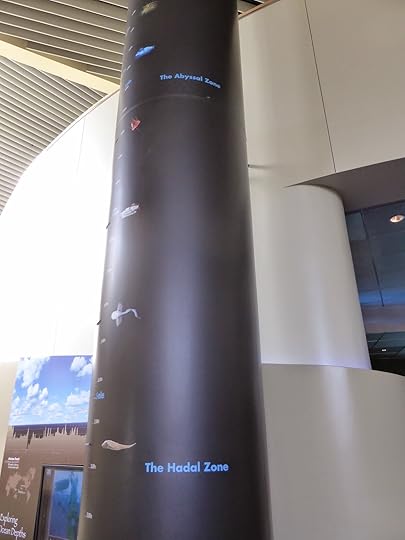
The next zone is the twilight zone (200 meters to 1,000 meters) The light here is faint and flickering. The thermocline causes great temperature changes. Bioluminescence begins to appear on life. The eyes on the fishes are larger and generally upward directed. Human eyes can detect nothing.
In the midnight layer (1000-4000 metres) there is constant darkness. The only light is from the bioluminescence of the animals themselves. The temperature is 4°C. There is no light, no day, no night. There is organic rainfall; dead microscopic organisms, faecal matter, the odd carcass.
The abyssal layer ( 4,000 to 6,000 meters). It is pitch-black. Three-quarters of the area of the deep-ocean floor lies in this zone. The temperature is near freezing and only a few creatures can be found at these crushing depths. The deepest fish ever found was at 8,372.
Then there is the Hadal Zone (6,000 to 10,911 meters) in the Mariana Trench. The weight of water overhead is that of 48 Boeing 747 jets). There are only tiny single-celled organisms; foraminifera.
And in the novel that I am writing, I have a character who is lying in a coma. And it struck me that the layers of the ocean could work as a metaphor for the character swimming in the deep blackness of his own conscious mind as it probes and tries to feel its way out/up into the real world. Or maybe that is what the character is hiding from.
My research tells me that much of what is universally believed about coma is not true but as it is a pleasant panacea for the relatives, the myths are allowed to persist. Patients so do not hear or see anything so they do not think. They just are.

As I would rather be happy than right I just refuse to believe this. I am told by experts that the little bits patients do recall are only because the incident occurred when they are 'close to the surface' anyway and ready to re-emerge. The fact that they have been played their favourite pop tunes and read their favourite stories is neither here nor there, except it makes the family feel they are doing something about the situation.
I have met a few folk who have been in a coma, (traumatic not induced) and they tell similar stories of picking up minutiae, the scent of peppermints, the fact the girlfriend had started smoking again as he could smell it off her breath and could recall conversations between his girlfriend and his mum- the latter giving the former a row for going back to the fags. That young lad was in a coma for 8 months, the girlfriend starting smoking again when the accident happened, so some of his memory seems to come from the early days ... before he dived deep if you like.
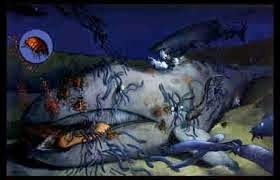
Whale fall. A long way from Skyfall.
So in my book I have that analogy going on. Then I saw the display on whale fall ( when a whale dies and lies decomposing on the floor of the ocean and creates a whole ecosystem of new life, and that ecosystem can go on for decades). And there was organ donorship right there, new life from death. That also fits in with the book and gave me its working title ‘Whale Fall’. I know the publisher will fling that out the minute they see it, but it is a good pet name for the book and will help keep me focussed.
 And the book is set in Glasgow. I want it to be in that area of the city with big hotels, good restaurants and classy nightclubs. The streets here are all named after the Crimean War and run down to the Clyde and Atlantic Quay… oh I thought that’s handy. So I have invented a new street in there called Inkermann Street. On that street is a building called the ‘Ocean Blue’. Many of the buildings here are old tobacco warehouses. The council has a policy that any new buyer can do as they wish with the building as long as they keep the front.
And the book is set in Glasgow. I want it to be in that area of the city with big hotels, good restaurants and classy nightclubs. The streets here are all named after the Crimean War and run down to the Clyde and Atlantic Quay… oh I thought that’s handy. So I have invented a new street in there called Inkermann Street. On that street is a building called the ‘Ocean Blue’. Many of the buildings here are old tobacco warehouses. The council has a policy that any new buyer can do as they wish with the building as long as they keep the front.
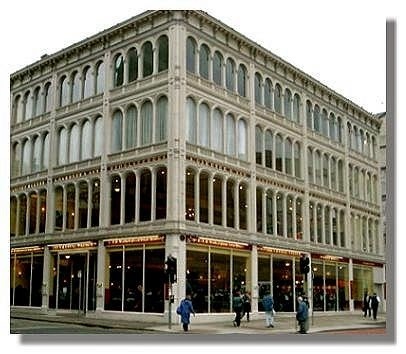
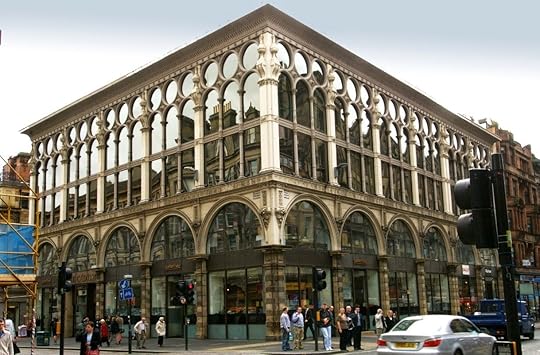

Who would not want to keep frontage like the above? So to have something like that as a base, I have designed a couple of penthouse flats, restaurants, offices but down the middle, in a central glass tube is a huge aquarium. And in that tube is another tube at huge pressure for creatures of the deep deep (very technical I know and I have no idea if a glass tube, no matter how thick, can contain pressurised water to keep a fish alive if it likes to live at a pressure of, say, three jumbo jets but it is my book and I can do as I want.) I have a patient who is a deep, deep tiny submarine person and he has a windscreen so the glass is capable of it!
Isn't MSU great!

So imagine sitting in a restaurant, very posh and watching the central wall which looks like this. Then as the evening goes on, the light falls, and the inner tube ( where the fish have their luminescence) will slowly become visible,
And out of all that blackness appears this......
.
The Prince Axel Wonderfish
Not pretty. But wondrous. And I do wonder what Prince Axel thought when he was told that is was being named after him. 'I saw this and I thought of you...'.
His is Thaumatichthys axeli, his Phylum: Chordata
 He has a luminescent organ dangling from his toothy jaws to attract prey. The first specimen was trawled from a depth of 11,778 feet by the Galathea expedition of 1950-52. He is black of course, about 18 inches long.Here is a very short video of him blinking his lure, but blink and you will miss it.
He has a luminescent organ dangling from his toothy jaws to attract prey. The first specimen was trawled from a depth of 11,778 feet by the Galathea expedition of 1950-52. He is black of course, about 18 inches long.Here is a very short video of him blinking his lure, but blink and you will miss it.
http://deepsea.tumblr.com/post/50334221304/astronomy-to-zoology-a-prince-axels-wonderfish
Caro Ramsay 20/02/2015
Making stuff up.
Did anybody read Susan's blog on Murder Is Everywhere last week and not think of a new Bond villain who sits and plots the downfall of western civilisation while watching the seahorses in his tank going about their own guerrilla tactics?
Or was that just me?
 I was wandering around the aquarium in Long Beach, tickling the horseshoe crabs etc and I saw this display showing the different layers of the ocean and who hangs around in each doing what.
I was wandering around the aquarium in Long Beach, tickling the horseshoe crabs etc and I saw this display showing the different layers of the ocean and who hangs around in each doing what.
The sunlight zone is from the surface to about 200 meters depth and it is the extent of visible light and heat from the sun. The thermocline - an interaction of wind, warm water and rapidly cooling water - is strongest in the tropics yet is almost non existent in the Polar regions. This ocean layer nourishes life of every colour. The colours lessen on the way down as the increasing lack of sunlight filters some out. The first colours to go are the reds, then oranges, yellows, greens, and then finally blues.

The next zone is the twilight zone (200 meters to 1,000 meters) The light here is faint and flickering. The thermocline causes great temperature changes. Bioluminescence begins to appear on life. The eyes on the fishes are larger and generally upward directed. Human eyes can detect nothing.
In the midnight layer (1000-4000 metres) there is constant darkness. The only light is from the bioluminescence of the animals themselves. The temperature is 4°C. There is no light, no day, no night. There is organic rainfall; dead microscopic organisms, faecal matter, the odd carcass.
The abyssal layer ( 4,000 to 6,000 meters). It is pitch-black. Three-quarters of the area of the deep-ocean floor lies in this zone. The temperature is near freezing and only a few creatures can be found at these crushing depths. The deepest fish ever found was at 8,372.
Then there is the Hadal Zone (6,000 to 10,911 meters) in the Mariana Trench. The weight of water overhead is that of 48 Boeing 747 jets). There are only tiny single-celled organisms; foraminifera.
And in the novel that I am writing, I have a character who is lying in a coma. And it struck me that the layers of the ocean could work as a metaphor for the character swimming in the deep blackness of his own conscious mind as it probes and tries to feel its way out/up into the real world. Or maybe that is what the character is hiding from.
My research tells me that much of what is universally believed about coma is not true but as it is a pleasant panacea for the relatives, the myths are allowed to persist. Patients so do not hear or see anything so they do not think. They just are.

As I would rather be happy than right I just refuse to believe this. I am told by experts that the little bits patients do recall are only because the incident occurred when they are 'close to the surface' anyway and ready to re-emerge. The fact that they have been played their favourite pop tunes and read their favourite stories is neither here nor there, except it makes the family feel they are doing something about the situation.
I have met a few folk who have been in a coma, (traumatic not induced) and they tell similar stories of picking up minutiae, the scent of peppermints, the fact the girlfriend had started smoking again as he could smell it off her breath and could recall conversations between his girlfriend and his mum- the latter giving the former a row for going back to the fags. That young lad was in a coma for 8 months, the girlfriend starting smoking again when the accident happened, so some of his memory seems to come from the early days ... before he dived deep if you like.

Whale fall. A long way from Skyfall.
So in my book I have that analogy going on. Then I saw the display on whale fall ( when a whale dies and lies decomposing on the floor of the ocean and creates a whole ecosystem of new life, and that ecosystem can go on for decades). And there was organ donorship right there, new life from death. That also fits in with the book and gave me its working title ‘Whale Fall’. I know the publisher will fling that out the minute they see it, but it is a good pet name for the book and will help keep me focussed.
 And the book is set in Glasgow. I want it to be in that area of the city with big hotels, good restaurants and classy nightclubs. The streets here are all named after the Crimean War and run down to the Clyde and Atlantic Quay… oh I thought that’s handy. So I have invented a new street in there called Inkermann Street. On that street is a building called the ‘Ocean Blue’. Many of the buildings here are old tobacco warehouses. The council has a policy that any new buyer can do as they wish with the building as long as they keep the front.
And the book is set in Glasgow. I want it to be in that area of the city with big hotels, good restaurants and classy nightclubs. The streets here are all named after the Crimean War and run down to the Clyde and Atlantic Quay… oh I thought that’s handy. So I have invented a new street in there called Inkermann Street. On that street is a building called the ‘Ocean Blue’. Many of the buildings here are old tobacco warehouses. The council has a policy that any new buyer can do as they wish with the building as long as they keep the front.


Who would not want to keep frontage like the above? So to have something like that as a base, I have designed a couple of penthouse flats, restaurants, offices but down the middle, in a central glass tube is a huge aquarium. And in that tube is another tube at huge pressure for creatures of the deep deep (very technical I know and I have no idea if a glass tube, no matter how thick, can contain pressurised water to keep a fish alive if it likes to live at a pressure of, say, three jumbo jets but it is my book and I can do as I want.) I have a patient who is a deep, deep tiny submarine person and he has a windscreen so the glass is capable of it!
Isn't MSU great!

So imagine sitting in a restaurant, very posh and watching the central wall which looks like this. Then as the evening goes on, the light falls, and the inner tube ( where the fish have their luminescence) will slowly become visible,
And out of all that blackness appears this......
.

The Prince Axel Wonderfish
Not pretty. But wondrous. And I do wonder what Prince Axel thought when he was told that is was being named after him. 'I saw this and I thought of you...'.
His is Thaumatichthys axeli, his Phylum: Chordata
 He has a luminescent organ dangling from his toothy jaws to attract prey. The first specimen was trawled from a depth of 11,778 feet by the Galathea expedition of 1950-52. He is black of course, about 18 inches long.Here is a very short video of him blinking his lure, but blink and you will miss it.
He has a luminescent organ dangling from his toothy jaws to attract prey. The first specimen was trawled from a depth of 11,778 feet by the Galathea expedition of 1950-52. He is black of course, about 18 inches long.Here is a very short video of him blinking his lure, but blink and you will miss it.http://deepsea.tumblr.com/post/50334221304/astronomy-to-zoology-a-prince-axels-wonderfish
Caro Ramsay 20/02/2015
Published on February 20, 2015 00:30
February 15, 2015
Deeply Dippy About the dinosaur
The fangs are out.
And the flippers are in.

Who wouldn't want that in the front room?
The Natural History Museum has just announced that Dippy is being retired. The rather splendid cast of diplodocus is being removed and being replaced by the skeleton of the blue whale.
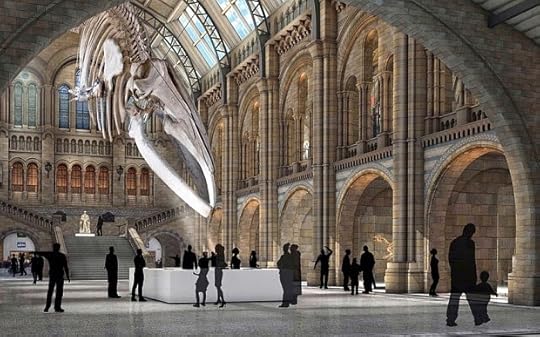
Artist impression of the new entrance
But not after a fight. Some of us it seems, are rather fond of Dippy and are not going to let him go without a fight.
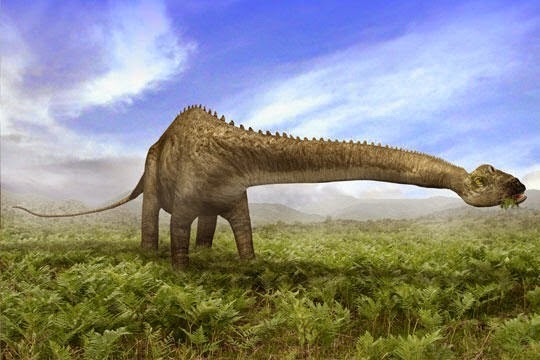
oldie but goldie
The plaster cast skeleton was a gift to the Museum from Andrew Carnegie (from Val McDermid and Ian Rankin country in the kingdom, of Fife) and he bears the name Diplodocuscarnegii for that reason. At that time, 1905, he was the largest dinosaur known.

bearded chappies nibbling canapes in wonder
Although there are other copies of Dippy... Dippy doubles…10 of them, decituplets? something… in Berlin, Paris and Milan, he is always associated with the Natural History Museum in London.
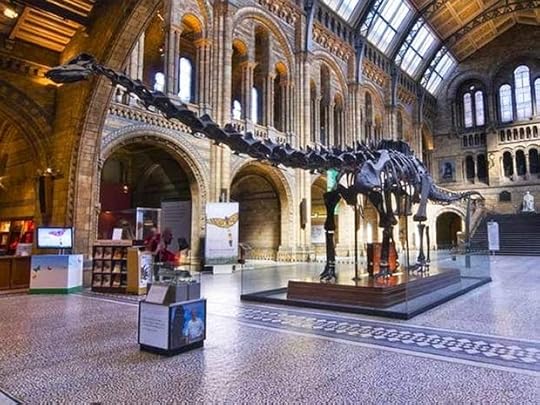
He has taken pride of place in the main hall since 1979 and he reflects the beautiful architecture around him. He seems to fit in a way that I’m not a blue whale would.
Dippy has appeared in numerous films and documentaries and is a bit of a star in his own right. He had his own twitter account, 'save Dippy' is trending in the world of hashtags. Petitions are being signed to keep him or her in place. (it is impossible to sex the diplodocus ... but as long as Dippy or Miss Dippy himself knows the difference that’s all that matters.)
Rumours are now abounding that the Museum have ill judged the denizens depth of devotion to Dippy.

Dippy fits the Monty Python theory of the dinosaur ie small at each end and big in the middle
If they have their way, over the next two years Dippy will be dismantled and replaced with a mounted blue whale skeleton that will dive down from above. It may be very conservative and environmental and worthy, but will it be fun! Museums must change with the times and the blue whale is an iconic image in the green movement to look after the planet, but a whale is a whale is a whale. I’ve seen them in the wild and on the tv. I’ve seen blue whale models in long beach aquarium for one instance… and it is impressive, they are impressive…
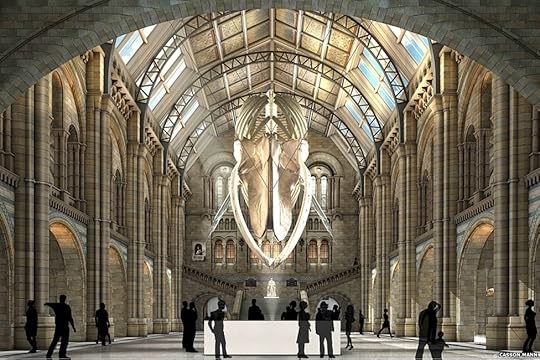 but Dippy is engaging, and he talks to the young. There is a sense of evolution when you talk to Dippy. Dippy discourse. Of course.
but Dippy is engaging, and he talks to the young. There is a sense of evolution when you talk to Dippy. Dippy discourse. Of course.

Over the last few years Dippy has raised nearly a million pounds in funds and the dinosaur exhibits that he heralds is the only one that always has a queue to get in. On our recent visit we saw the sign that said an hour to queue from here. And that was a school day, early Friday morning. Instead we watched homo sapiens fall over on the ice rink, where the sun had melted the top inch of the surface so there was a lot of water sloshing about. Anybody who fell got very wet. Especially on their backside. Homo sapiens soakius gluteus.
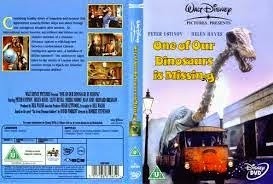 So what is going to happen to Dippy's remains. Maybe he will be kidnapped for his own good, as in One of our dinosaurs is missing. But he is a senior citizen, a golden oldie, a crumbly or as we call them in Glasgow, a coffin dodger. He is over a hundred years old, he is fragile and delicate. Decorously Delicate Dippy. So touring seems out the question. He could be set free and put outside to graze on the grass at the front of the museum but he would need to be recast to withstand the weather and therefore he would not be not Dippy the delectable. The thought of him being wrapped up and put in a box with a bar code on top is dastardly and deplorable.
So what is going to happen to Dippy's remains. Maybe he will be kidnapped for his own good, as in One of our dinosaurs is missing. But he is a senior citizen, a golden oldie, a crumbly or as we call them in Glasgow, a coffin dodger. He is over a hundred years old, he is fragile and delicate. Decorously Delicate Dippy. So touring seems out the question. He could be set free and put outside to graze on the grass at the front of the museum but he would need to be recast to withstand the weather and therefore he would not be not Dippy the delectable. The thought of him being wrapped up and put in a box with a bar code on top is dastardly and deplorable.
 He has 292 bones, 36 packing cases brought him to London, it took four months to build him and he was unveiled on Friday 12th May 1905. He was taken down during the war to protect him and over the years he has been re configured as paleontologists advanced research and understood more of how Dippy would look and how he would move. Originally his tail and head were down, now the neck is horizontal and the tail forms a graceful arc over the heads of his visitors.
He has 292 bones, 36 packing cases brought him to London, it took four months to build him and he was unveiled on Friday 12th May 1905. He was taken down during the war to protect him and over the years he has been re configured as paleontologists advanced research and understood more of how Dippy would look and how he would move. Originally his tail and head were down, now the neck is horizontal and the tail forms a graceful arc over the heads of his visitors.
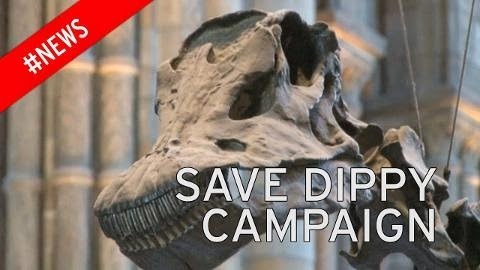
As I said there is now a petition. it attracted 22,574 signatures in just one day and novelty pop duo Right Said Fred have released a single to help prevent Dippy’s demise. Their hit song was called deeply dippy so it's not a huge lyrical leap.
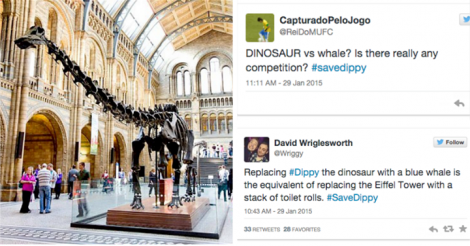 The lower comment says that replacing Dippy with a blue whale is like replacing the Eiffel Tower with a stack of toilet rolls.
The lower comment says that replacing Dippy with a blue whale is like replacing the Eiffel Tower with a stack of toilet rolls.
The director of the zoo says that he loves Dippy, too but the dinosaur has had a good 35 years in the limelight and he is ready for something new.
I've known men to use that theory about their wife.
Caro Ramsay
And the flippers are in.

Who wouldn't want that in the front room?
The Natural History Museum has just announced that Dippy is being retired. The rather splendid cast of diplodocus is being removed and being replaced by the skeleton of the blue whale.

Artist impression of the new entrance
But not after a fight. Some of us it seems, are rather fond of Dippy and are not going to let him go without a fight.

oldie but goldie
The plaster cast skeleton was a gift to the Museum from Andrew Carnegie (from Val McDermid and Ian Rankin country in the kingdom, of Fife) and he bears the name Diplodocuscarnegii for that reason. At that time, 1905, he was the largest dinosaur known.

bearded chappies nibbling canapes in wonder
Although there are other copies of Dippy... Dippy doubles…10 of them, decituplets? something… in Berlin, Paris and Milan, he is always associated with the Natural History Museum in London.

He has taken pride of place in the main hall since 1979 and he reflects the beautiful architecture around him. He seems to fit in a way that I’m not a blue whale would.
Dippy has appeared in numerous films and documentaries and is a bit of a star in his own right. He had his own twitter account, 'save Dippy' is trending in the world of hashtags. Petitions are being signed to keep him or her in place. (it is impossible to sex the diplodocus ... but as long as Dippy or Miss Dippy himself knows the difference that’s all that matters.)
Rumours are now abounding that the Museum have ill judged the denizens depth of devotion to Dippy.

Dippy fits the Monty Python theory of the dinosaur ie small at each end and big in the middle
If they have their way, over the next two years Dippy will be dismantled and replaced with a mounted blue whale skeleton that will dive down from above. It may be very conservative and environmental and worthy, but will it be fun! Museums must change with the times and the blue whale is an iconic image in the green movement to look after the planet, but a whale is a whale is a whale. I’ve seen them in the wild and on the tv. I’ve seen blue whale models in long beach aquarium for one instance… and it is impressive, they are impressive…
 but Dippy is engaging, and he talks to the young. There is a sense of evolution when you talk to Dippy. Dippy discourse. Of course.
but Dippy is engaging, and he talks to the young. There is a sense of evolution when you talk to Dippy. Dippy discourse. Of course.
Over the last few years Dippy has raised nearly a million pounds in funds and the dinosaur exhibits that he heralds is the only one that always has a queue to get in. On our recent visit we saw the sign that said an hour to queue from here. And that was a school day, early Friday morning. Instead we watched homo sapiens fall over on the ice rink, where the sun had melted the top inch of the surface so there was a lot of water sloshing about. Anybody who fell got very wet. Especially on their backside. Homo sapiens soakius gluteus.
 So what is going to happen to Dippy's remains. Maybe he will be kidnapped for his own good, as in One of our dinosaurs is missing. But he is a senior citizen, a golden oldie, a crumbly or as we call them in Glasgow, a coffin dodger. He is over a hundred years old, he is fragile and delicate. Decorously Delicate Dippy. So touring seems out the question. He could be set free and put outside to graze on the grass at the front of the museum but he would need to be recast to withstand the weather and therefore he would not be not Dippy the delectable. The thought of him being wrapped up and put in a box with a bar code on top is dastardly and deplorable.
So what is going to happen to Dippy's remains. Maybe he will be kidnapped for his own good, as in One of our dinosaurs is missing. But he is a senior citizen, a golden oldie, a crumbly or as we call them in Glasgow, a coffin dodger. He is over a hundred years old, he is fragile and delicate. Decorously Delicate Dippy. So touring seems out the question. He could be set free and put outside to graze on the grass at the front of the museum but he would need to be recast to withstand the weather and therefore he would not be not Dippy the delectable. The thought of him being wrapped up and put in a box with a bar code on top is dastardly and deplorable. He has 292 bones, 36 packing cases brought him to London, it took four months to build him and he was unveiled on Friday 12th May 1905. He was taken down during the war to protect him and over the years he has been re configured as paleontologists advanced research and understood more of how Dippy would look and how he would move. Originally his tail and head were down, now the neck is horizontal and the tail forms a graceful arc over the heads of his visitors.
He has 292 bones, 36 packing cases brought him to London, it took four months to build him and he was unveiled on Friday 12th May 1905. He was taken down during the war to protect him and over the years he has been re configured as paleontologists advanced research and understood more of how Dippy would look and how he would move. Originally his tail and head were down, now the neck is horizontal and the tail forms a graceful arc over the heads of his visitors.
As I said there is now a petition. it attracted 22,574 signatures in just one day and novelty pop duo Right Said Fred have released a single to help prevent Dippy’s demise. Their hit song was called deeply dippy so it's not a huge lyrical leap.
 The lower comment says that replacing Dippy with a blue whale is like replacing the Eiffel Tower with a stack of toilet rolls.
The lower comment says that replacing Dippy with a blue whale is like replacing the Eiffel Tower with a stack of toilet rolls.The director of the zoo says that he loves Dippy, too but the dinosaur has had a good 35 years in the limelight and he is ready for something new.
I've known men to use that theory about their wife.
Caro Ramsay
Published on February 15, 2015 02:42
February 6, 2015
Sawney ( Has) Been
I was running about as I do, listening to a fine account of the first serial killer well documented in British history, in Colin Wilson’s Mammoth Book Of Murder.
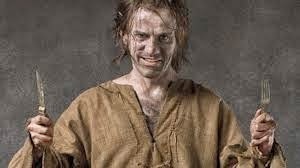
So to set the scene; Scotland. 1400, James 1st is on the throne. Edinburgh is little more than a village. Glasgow, which means dark glen, is exactly that. All of Scotland is wild and green. And cold. And empty.(Not much has changed)
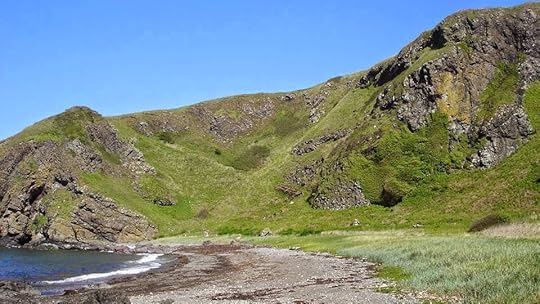
And then there started a reign of terror. Down in Galloway people started to go missing. Travellers on the coast road simply vanished off the face of the earth. At first it was thought to be wolves but there was never any trace left, no bones, no clothes, no jewels. When the list of disappearances topped a thousand over a period of twenty plus years, the King sent out a posse. They hung a few tramps, a few innkeepers and anybody else they didn’t like the look of. But the disappearances continued.
Then a couple were riding their horses on the coastal path coming home from a fair. Savages appeared, dragged the woman her from the horse, slitting her throat and disembowelling her there and then. The man, still on his horse, fought with his cutlass until some other travellers came round the corner, returning from the same fair. The attackers fled.
The horse and the man were the first survivors in 25 years.
Word got back to the King who turned up four days later with a small army of 400 men. They found nothing. Eventually they went down to the beach and at low tide rode along looking up at the caves in the cliff face. Narrow and jaggy, maybe broad enough to allow a man through but little more than that. Then two of the hunting dogs got a scent and ran up to a cave mouth. Once past the narrow entrance the cave widened out, the king recalled his men and waited for torches to be lit.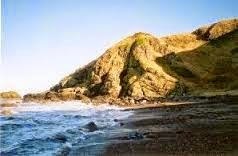
Outside the caves the dogs went crazy. Deep inside were 48 people living in squalor, body parts lay around the cave, some hanging from higher rocks, clothes and jewels scattered the floor. The cave is said to have been 200 feet deep and its entrance became totally submerged at high tide.
They were all captured and taken back to Edinburgh as the King’s men buried the remains of the dead.
The leader was identified Sawney Bean who had been born Alexander Bean in East Lothian. He had left Leith 25 years before with his wife. They had 8 sons and 6 daughters, 18 grandsons and 14 granddaughters all inbred. And they were cannibals. The story appears well documented in The Newgate Calendar, a crime catalogue of the notorious Newgate Prison in London. It says that Bean was the son of a ditch digger and hedge trimmer but Bean Jnr soon realised he had no taste for honest toil.
And a taste for human flesh.
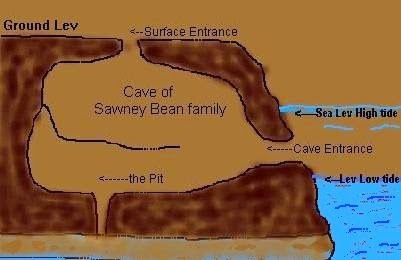 The lay out of the cave
The lay out of the cave
All were executed without trial because the king regarded them as beasts and therefore had no right of trial, no right to any kind of human dignity. The men had their hands and feet cut off and were left to bleed to death. The women were all burned alive in three separate fires. The chronicler John Nicolson said ‘They all died with no repentance, cursing up to the last gasp of life.’
The story of Sawney Bean has been used time and time again in horror films and books. Wes Cravens, The Hills have Eyes for example.
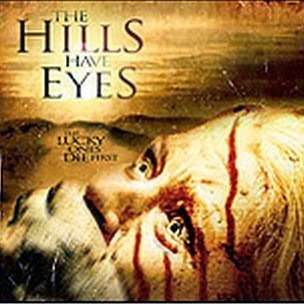
None of it is true.
It is now popularly thought, with some pride it has to be said, that it was all anti-Scottish propaganda to portray the Scots as ‘dangerous savages’ at a time of political difficulties within the Union.
 There are many things wrong with the picture. The corpse, the kilt, plaid with laces!!!
There are many things wrong with the picture. The corpse, the kilt, plaid with laces!!!
Scottish historian Dr Louise Yeoman says about the books published about the story: "the books it sold were published not in Scotland but in England, at a time when there was widespread prejudice against Scots." She points out that despite the story being set in various times, the story of Sawney Bean cannot be found until the times of the Jacobite risings. The English were looking to show the Scots in a negative way “either as subjects of ridicule or as having a sinister nature.” Dr Yeoman adds: "The name Sawney itself was a popular English name for the barbarous cartoon Scot."It's like calling a cartoon Irishman Paddy.” James The King, with a better stylist.
James The King, with a better stylist.
There is huge historical inaccuracy. His reign of terror ranges from James I of Scotland in the early 1400s, to James VI of Scotland (who was James I of England) around the turn of the 17th Century. So, legend rather than reality. David Haymam, in the film....
David Haymam, in the film....

where he stalks the city in a black cab then takes his victims out to the hills...The Flesh Of Man...
I did giggle when Dr Yeoman pointed out a very humane fact. Although King James was a keen hunter he was unlikely to have put himself in danger by leading this perilous trek against the savage beats living in the caves. He would have sent somebody else. If he had gone there and rounded up the tribe by his own fair hand, we would never have heard the end of it and he would be regarded as a hero of the time.
He wasn’t.
Reading round the internet, it seems cannibalism was not unknown in medieval Scotland. And Galloway can still be a pretty wild place. I know. I've been to the Wigtown book Festival.
Caro Ramsay 06-02-15

So to set the scene; Scotland. 1400, James 1st is on the throne. Edinburgh is little more than a village. Glasgow, which means dark glen, is exactly that. All of Scotland is wild and green. And cold. And empty.(Not much has changed)

And then there started a reign of terror. Down in Galloway people started to go missing. Travellers on the coast road simply vanished off the face of the earth. At first it was thought to be wolves but there was never any trace left, no bones, no clothes, no jewels. When the list of disappearances topped a thousand over a period of twenty plus years, the King sent out a posse. They hung a few tramps, a few innkeepers and anybody else they didn’t like the look of. But the disappearances continued.
Then a couple were riding their horses on the coastal path coming home from a fair. Savages appeared, dragged the woman her from the horse, slitting her throat and disembowelling her there and then. The man, still on his horse, fought with his cutlass until some other travellers came round the corner, returning from the same fair. The attackers fled.
The horse and the man were the first survivors in 25 years.
Word got back to the King who turned up four days later with a small army of 400 men. They found nothing. Eventually they went down to the beach and at low tide rode along looking up at the caves in the cliff face. Narrow and jaggy, maybe broad enough to allow a man through but little more than that. Then two of the hunting dogs got a scent and ran up to a cave mouth. Once past the narrow entrance the cave widened out, the king recalled his men and waited for torches to be lit.

Outside the caves the dogs went crazy. Deep inside were 48 people living in squalor, body parts lay around the cave, some hanging from higher rocks, clothes and jewels scattered the floor. The cave is said to have been 200 feet deep and its entrance became totally submerged at high tide.
They were all captured and taken back to Edinburgh as the King’s men buried the remains of the dead.
The leader was identified Sawney Bean who had been born Alexander Bean in East Lothian. He had left Leith 25 years before with his wife. They had 8 sons and 6 daughters, 18 grandsons and 14 granddaughters all inbred. And they were cannibals. The story appears well documented in The Newgate Calendar, a crime catalogue of the notorious Newgate Prison in London. It says that Bean was the son of a ditch digger and hedge trimmer but Bean Jnr soon realised he had no taste for honest toil.
And a taste for human flesh.
 The lay out of the cave
The lay out of the cave All were executed without trial because the king regarded them as beasts and therefore had no right of trial, no right to any kind of human dignity. The men had their hands and feet cut off and were left to bleed to death. The women were all burned alive in three separate fires. The chronicler John Nicolson said ‘They all died with no repentance, cursing up to the last gasp of life.’
The story of Sawney Bean has been used time and time again in horror films and books. Wes Cravens, The Hills have Eyes for example.

None of it is true.
It is now popularly thought, with some pride it has to be said, that it was all anti-Scottish propaganda to portray the Scots as ‘dangerous savages’ at a time of political difficulties within the Union.
 There are many things wrong with the picture. The corpse, the kilt, plaid with laces!!!
There are many things wrong with the picture. The corpse, the kilt, plaid with laces!!! Scottish historian Dr Louise Yeoman says about the books published about the story: "the books it sold were published not in Scotland but in England, at a time when there was widespread prejudice against Scots." She points out that despite the story being set in various times, the story of Sawney Bean cannot be found until the times of the Jacobite risings. The English were looking to show the Scots in a negative way “either as subjects of ridicule or as having a sinister nature.” Dr Yeoman adds: "The name Sawney itself was a popular English name for the barbarous cartoon Scot."It's like calling a cartoon Irishman Paddy.”
 James The King, with a better stylist.
James The King, with a better stylist.There is huge historical inaccuracy. His reign of terror ranges from James I of Scotland in the early 1400s, to James VI of Scotland (who was James I of England) around the turn of the 17th Century. So, legend rather than reality.
 David Haymam, in the film....
David Haymam, in the film....

where he stalks the city in a black cab then takes his victims out to the hills...The Flesh Of Man...
I did giggle when Dr Yeoman pointed out a very humane fact. Although King James was a keen hunter he was unlikely to have put himself in danger by leading this perilous trek against the savage beats living in the caves. He would have sent somebody else. If he had gone there and rounded up the tribe by his own fair hand, we would never have heard the end of it and he would be regarded as a hero of the time.
He wasn’t.
Reading round the internet, it seems cannibalism was not unknown in medieval Scotland. And Galloway can still be a pretty wild place. I know. I've been to the Wigtown book Festival.
Caro Ramsay 06-02-15
Published on February 06, 2015 08:43
February 1, 2015
The British Museum
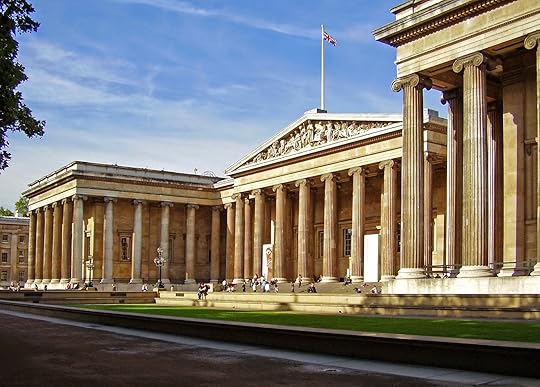
The British Museum was founded 1753. It now houses over 8 million objects.


It is famous for many things including the objective of our visit – the Rosetta Stone, it is infamous for a few too, the Elgin Marbles.

Like all government funded museums, it is free. Apart from the special exhibitions but you can spend days wandering around looking at ‘stuff’ and thinking….Wow, how old is that?What is it worth?Who did we steal it from?Do they want it back?

The BM was founded by Sir Hans Sloan, physician and naturalist (1660–1753). He left his collection of over 70 000 artefacts, drawings and paintings to King George II.There is so much to look at and photograph, I’m only blogging about the bits I like. Durer is probably my favourite artist, along with Degas ( you can almost smell the horses in Jockey’s in the Rain).Sloan had purchased much of Durer’s work. I like this….
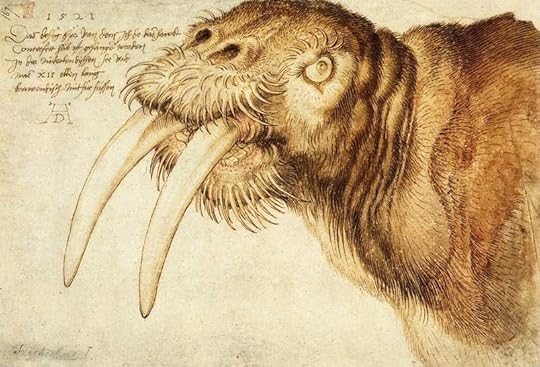 The Walrus, 1521.
The Walrus, 1521.Initially the collection was housed in Montague House. The BM and the British Library were one and the same – the latter being formed from many collections including the Royal Libraries (four of them to be precise). The British Library still owns the Lindisfarne Gospels and the only surviving copy of Beowulf.
The British Library contains a copy of every book published in this country and, I think by Act of Parliament, a copy of every new book published here must be sent to the Library. I have no idea what happens to the publisher if they fail to do this. The library therefore expands every year and it needs… wait for it…. 1 ¼ miles of new shelf space each year.
It contains David Garrick’s collection of 1,000 printed plays!
When a trustee gifted a library of 20 000 books, it took twenty one horse drawn carriages to move them. That was January 1847.
When T E Lawrence brought back what he had ‘excavated’ at Carchemish, the whole collection had to be evacuated in 1918 due to the threat of wartime bombing. It was moved, piece by piece by the postal railway from Holburn (pronounced Hoburn to annoy tourists), to Aberystwyth and Malvern.
The library spilt from the BM to move to a new location in St Pancras, the final books were moved in 1997.
But more than a hundred years before that, the trustees had realised that Montague House was no longer fit for purpose, the collection was getting too big. The light was difficult and there were issues with dampness and humidity. They looked at a few alternative sites, including one called Buckingham House but they rejected it on the grounds of its location.I think somebody else bought it and converted it for residential use.
In 1895 the trustees purchased 69 houses that surrounded the Museum and started demolishing them so they could expand further. In the 1970’s the museum expanded again. It became more user friendly. That was my first visit there, as a wee tiny person to see the "Treasures of Tutankhamun" in 1972. I only remember my legs hurting because we had to queue for so long, and being constantly told not to get sticky fingermarks on the glass.

It attracted 1,694,117 visitors ( four of them Ramsays) .It was the most successful exhibition in British history.
It was revamped recently, the huge central quadrangle the ‘Queen Elizabeth II Great Court’ ( the largest covered square in Europe) opened in 2000. I believe that no two panes of glass in the roof are the same, but I didn’t check.

From the original collection, there are now over thirteen million objects at the British Museum, 70 million at the Natural History Museum and 150 million at the British Library. The BM website has the largest online database of any museum in the world. Over 2,000,000 individual objects.From 2012 to 2013, the museum increased its footfall by 20%,. 6.7 million visitors.Here are my highlights, in no particular order.
Room 4 – The Rosetta Stone, the key to the decipherment of Egyptian hieroglyphs, 196 BC. My other half was very excited by this.
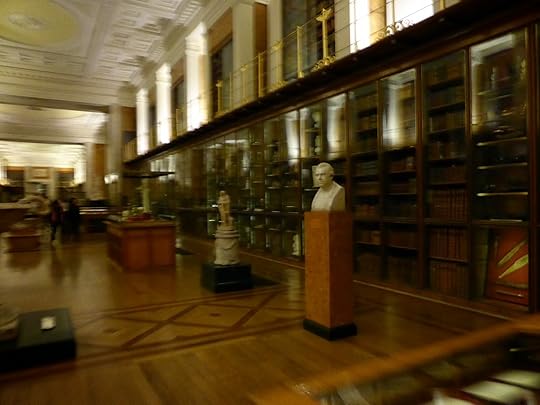 But in the Kings Library...
But in the Kings Library...
There is a touchable replica....
 And then...
And then...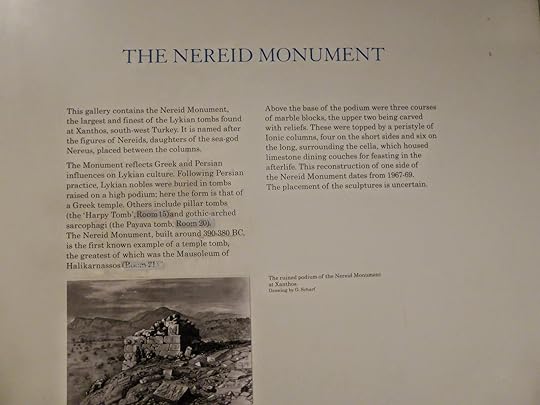

Room 17 – Reconstruction of the Nereid Monument, c. 390 BC

Room 21 – Mausoleum at Halicarnassus, one of the Seven Wonders of the Ancient World, mid 4th century BC
 A big nasty dog, but looking lovingly at its owner who is probably just opening the ancient equivalent of Chappie Doggy Delight. It is the Jennings Dog, statue of a Molossian guard dog, (2nd Century AD)
A big nasty dog, but looking lovingly at its owner who is probably just opening the ancient equivalent of Chappie Doggy Delight. It is the Jennings Dog, statue of a Molossian guard dog, (2nd Century AD)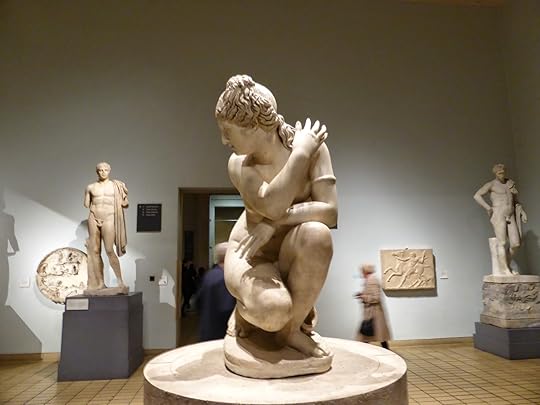
Room 23 - The famous version of the 'Crouching Venus', Roman, c. 1st Century AD
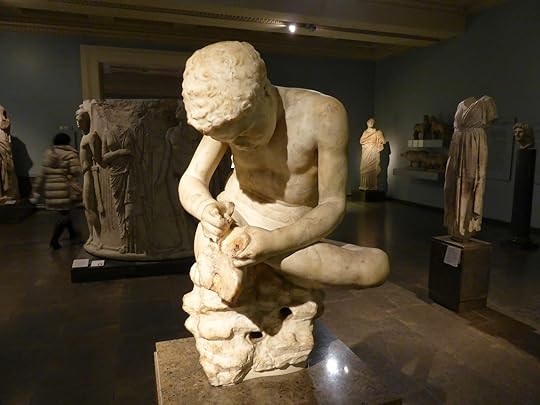
Room 22 – Roman marble copy of the famous 'Spinario (Boy with Thorn)', c. 1st Century AD

And a beautiful horse to finish with.
Caro
Published on February 01, 2015 10:09
January 11, 2015
Diana, Princess of Wales. Lady Di. ...
Diana, Princess of Wales. Lady Di.

Princess Diana was a woman who courted controversy all her life. She divided opinion everywhere she went but appeared to be so loved by all and sundry that it was almost sacrilege to say anything against her. At the time.
I’m sure there is little doubt that the Royal family (or the establishment) used her to produce an heir and a spare as the saying goes while Charles’s heart lay firmly elsewhere with his first love, Camilla.
The tragedy in the Pont de L’Alma Tunnel firmly cemented Diana in the hearts of her adoring public as a woman who could do no wrong. Nobody could comment adversely after the tragedy of a young, vibrant woman dying in such terrible circumstances. It was an accident that robbed three people of their lives. And the boys of their mum.
But Camilla has stood the test of time as Charles' wife, the Duchess of Cornwall. She has kept her mouth shut as controversy raged around her and she goes about her business in quiet dignity. She’s not beautiful, she’s a big raggedly, she doesn’t wear posh clothes well, she nips out the back for a quick cigarette and people are starting to admire her for it. Especially women of a certain age who see a kindred spirit in her and not a clothes horse. She appeared on the TV on Christmas Eve visiting Battersea dogs home. The programme was about the dogs, not Camilla, but there was a little bit of footage of her getting out the car with a Jack Russell (both rescued) under each armpit, Dogs were handed back and forth as handshakes and formal introductions were made. It was obvious she was a little uncomfortable with that and wanted to get on with seeing the kennels. Camilla and the rescue Russell, picture from the Daily Mail
Camilla and the rescue Russell, picture from the Daily Mail
The presenter, Paul O’Grady had dressed a litter of ten puppies in Xmas jumpers… well was desperately trying to every time the camera went back to him. He was involved in yet another tussle of ears, tails, teeth, fur and pee. Then Camilla came in, curtsey, handshakes, then Camilla got on her knees to say hello to the puppies and was swamped in tails, fur balls, jumpers etc. then she half turned and asked for a hand to help her get up. She earned a lot of fans doing that and letting it be filmed.
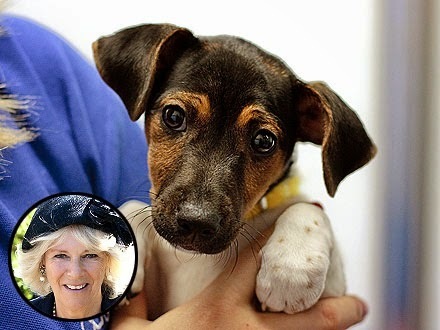
I have been to Hyde Park twice to try to find the Diana memorial fountain and failed, so in intrepid blogger style I set off for a third time, map in hand, the significant other following behind with camera.The problem is, it’s not a fountain. Well not in the uppy downy sense.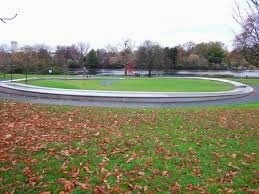 This in the memorial fountain
This in the memorial fountain
We found it in the southwest corner of the park, south of the Serpentine lake. It has been there since 6 July 2004 when it was officially opened by Queen Elizabeth with Diana's younger brother Charles Spencer, her ex-husband Prince Charles, and her sons William and Harry also in attendance.It caused controversy at the time, and I’m not sure about its popularity now. The most common thing overheard around it is ‘is that it?’ with a huge degree of disappointment. Ok it was designed by Kathryn Gustafson, (cost £3.6 million) to provide a fitting memorial for the princess and does credit to the amazing person that she was."
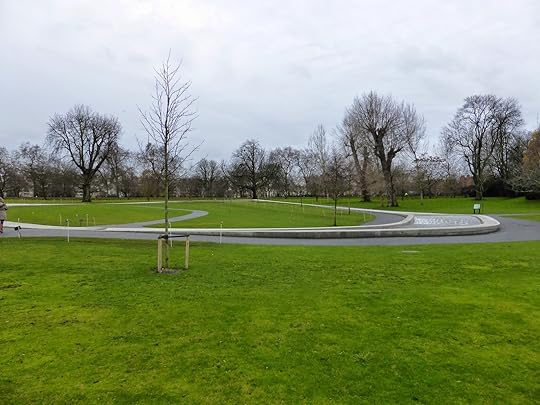 It has 545 individual pieces of Cornish granite made into an oval stone fountain through which runs some water. The guide book says it is surrounded by lush verdant grass, it’s surrounded by mud. They reworked the area around the fountain to improve the drainage but frankly, it looked a mess.It’s 3 to 6 m wide and it runs at an angle so the water gets pumped back up to the top.The two sides are different, to reflect the two sides of Diana’s life; happy and turmoil.It was supposed to allow paddling and contemplation with folk standing in the water, but three girls were hospitalised soon after it opened. It was very slippy and it was closed. Beautiful but dangerous. Maybe that is a truer comment on Diana.
It has 545 individual pieces of Cornish granite made into an oval stone fountain through which runs some water. The guide book says it is surrounded by lush verdant grass, it’s surrounded by mud. They reworked the area around the fountain to improve the drainage but frankly, it looked a mess.It’s 3 to 6 m wide and it runs at an angle so the water gets pumped back up to the top.The two sides are different, to reflect the two sides of Diana’s life; happy and turmoil.It was supposed to allow paddling and contemplation with folk standing in the water, but three girls were hospitalised soon after it opened. It was very slippy and it was closed. Beautiful but dangerous. Maybe that is a truer comment on Diana.
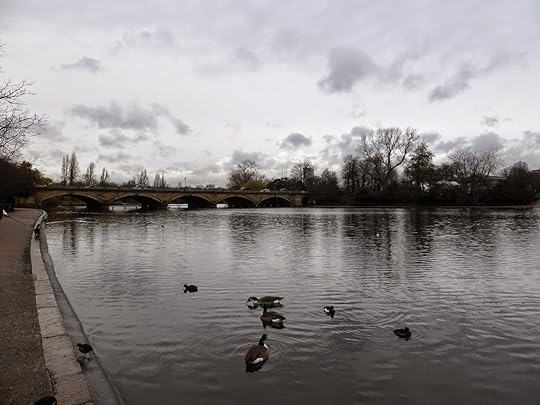 I prefer the view looking the other way
I prefer the view looking the other way
So, in December 2004, another alteration project was started. This involved work on the drainage, together with laying new hard surfaces on some of the most frequently walked areas of the site and the planting of a special hard wearing rye grass mix in others.I am not particularly fond of the royal family, they do a good job. But then so do I. I went to work on the day of Diana’s funeral.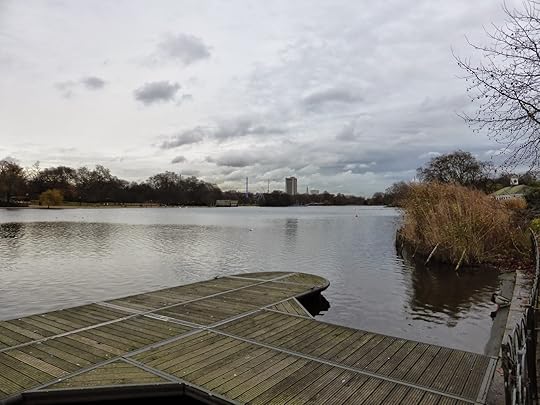 Pier on the Serpentine
Pier on the Serpentine
I got my degree from Princess Anne I refused to curtesy, I had worked for it. But she and I got chatting about horses and that was that.She was at our Uni three times. (Anne I mean ) She sat on a filing cabinet at our tutorial point . She explained that she had just had her anti malarial tablets and felt terrible, so against protocol we all sat down and had a great chat about homeopathy!
I met her again at a guide dog thing, she asked how I had arrived and what the Edinburgh traffic was like as she was in a hurry to get to the rugby. I once had a chat with Prince Charles about flat feet. He was ok, professionally interested. Interested in my accent and where I was from.
I met Diana at the uni too. She’s a good eight inches taller than me and was two stone lighter, she looked like bones with fancy clothes draped over them. Got the impression there was not a lot going on between her ears. But I know from other students that she sparked into life downstairs at the kiddies clinic where she was talking animatedly about the babies and their treatments so I guess it’s each to their own.
Famously, she hated Scotland.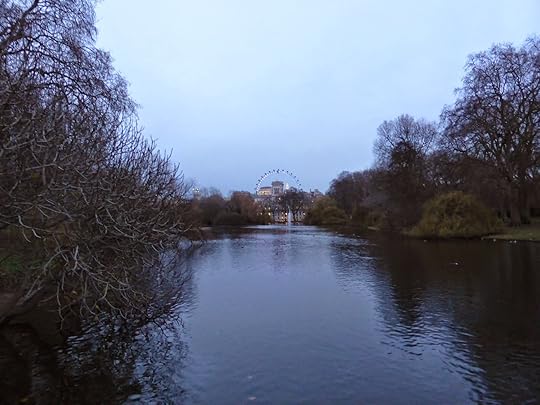 Twilight in Hyde Park
Twilight in Hyde Park
Just reading that back, it sounds as though I move in high circles but I trained at the British School of Osteopathic Medicine, that's in the middle of London, ten minutes walk from Buckingham Palace and Charles has always had a huge interest in complementary therapy, Anne was a patron of our college hence they were always popping in and out !!
Caro

Princess Diana was a woman who courted controversy all her life. She divided opinion everywhere she went but appeared to be so loved by all and sundry that it was almost sacrilege to say anything against her. At the time.
I’m sure there is little doubt that the Royal family (or the establishment) used her to produce an heir and a spare as the saying goes while Charles’s heart lay firmly elsewhere with his first love, Camilla.
The tragedy in the Pont de L’Alma Tunnel firmly cemented Diana in the hearts of her adoring public as a woman who could do no wrong. Nobody could comment adversely after the tragedy of a young, vibrant woman dying in such terrible circumstances. It was an accident that robbed three people of their lives. And the boys of their mum.
But Camilla has stood the test of time as Charles' wife, the Duchess of Cornwall. She has kept her mouth shut as controversy raged around her and she goes about her business in quiet dignity. She’s not beautiful, she’s a big raggedly, she doesn’t wear posh clothes well, she nips out the back for a quick cigarette and people are starting to admire her for it. Especially women of a certain age who see a kindred spirit in her and not a clothes horse. She appeared on the TV on Christmas Eve visiting Battersea dogs home. The programme was about the dogs, not Camilla, but there was a little bit of footage of her getting out the car with a Jack Russell (both rescued) under each armpit, Dogs were handed back and forth as handshakes and formal introductions were made. It was obvious she was a little uncomfortable with that and wanted to get on with seeing the kennels.
 Camilla and the rescue Russell, picture from the Daily Mail
Camilla and the rescue Russell, picture from the Daily MailThe presenter, Paul O’Grady had dressed a litter of ten puppies in Xmas jumpers… well was desperately trying to every time the camera went back to him. He was involved in yet another tussle of ears, tails, teeth, fur and pee. Then Camilla came in, curtsey, handshakes, then Camilla got on her knees to say hello to the puppies and was swamped in tails, fur balls, jumpers etc. then she half turned and asked for a hand to help her get up. She earned a lot of fans doing that and letting it be filmed.

I have been to Hyde Park twice to try to find the Diana memorial fountain and failed, so in intrepid blogger style I set off for a third time, map in hand, the significant other following behind with camera.The problem is, it’s not a fountain. Well not in the uppy downy sense.
 This in the memorial fountain
This in the memorial fountainWe found it in the southwest corner of the park, south of the Serpentine lake. It has been there since 6 July 2004 when it was officially opened by Queen Elizabeth with Diana's younger brother Charles Spencer, her ex-husband Prince Charles, and her sons William and Harry also in attendance.It caused controversy at the time, and I’m not sure about its popularity now. The most common thing overheard around it is ‘is that it?’ with a huge degree of disappointment. Ok it was designed by Kathryn Gustafson, (cost £3.6 million) to provide a fitting memorial for the princess and does credit to the amazing person that she was."
 It has 545 individual pieces of Cornish granite made into an oval stone fountain through which runs some water. The guide book says it is surrounded by lush verdant grass, it’s surrounded by mud. They reworked the area around the fountain to improve the drainage but frankly, it looked a mess.It’s 3 to 6 m wide and it runs at an angle so the water gets pumped back up to the top.The two sides are different, to reflect the two sides of Diana’s life; happy and turmoil.It was supposed to allow paddling and contemplation with folk standing in the water, but three girls were hospitalised soon after it opened. It was very slippy and it was closed. Beautiful but dangerous. Maybe that is a truer comment on Diana.
It has 545 individual pieces of Cornish granite made into an oval stone fountain through which runs some water. The guide book says it is surrounded by lush verdant grass, it’s surrounded by mud. They reworked the area around the fountain to improve the drainage but frankly, it looked a mess.It’s 3 to 6 m wide and it runs at an angle so the water gets pumped back up to the top.The two sides are different, to reflect the two sides of Diana’s life; happy and turmoil.It was supposed to allow paddling and contemplation with folk standing in the water, but three girls were hospitalised soon after it opened. It was very slippy and it was closed. Beautiful but dangerous. Maybe that is a truer comment on Diana.
 I prefer the view looking the other way
I prefer the view looking the other waySo, in December 2004, another alteration project was started. This involved work on the drainage, together with laying new hard surfaces on some of the most frequently walked areas of the site and the planting of a special hard wearing rye grass mix in others.I am not particularly fond of the royal family, they do a good job. But then so do I. I went to work on the day of Diana’s funeral.
 Pier on the Serpentine
Pier on the SerpentineI got my degree from Princess Anne I refused to curtesy, I had worked for it. But she and I got chatting about horses and that was that.She was at our Uni three times. (Anne I mean ) She sat on a filing cabinet at our tutorial point . She explained that she had just had her anti malarial tablets and felt terrible, so against protocol we all sat down and had a great chat about homeopathy!
I met her again at a guide dog thing, she asked how I had arrived and what the Edinburgh traffic was like as she was in a hurry to get to the rugby. I once had a chat with Prince Charles about flat feet. He was ok, professionally interested. Interested in my accent and where I was from.
I met Diana at the uni too. She’s a good eight inches taller than me and was two stone lighter, she looked like bones with fancy clothes draped over them. Got the impression there was not a lot going on between her ears. But I know from other students that she sparked into life downstairs at the kiddies clinic where she was talking animatedly about the babies and their treatments so I guess it’s each to their own.
Famously, she hated Scotland.
 Twilight in Hyde Park
Twilight in Hyde ParkJust reading that back, it sounds as though I move in high circles but I trained at the British School of Osteopathic Medicine, that's in the middle of London, ten minutes walk from Buckingham Palace and Charles has always had a huge interest in complementary therapy, Anne was a patron of our college hence they were always popping in and out !!
Caro
Published on January 11, 2015 09:34
Caro Ramsay's Blog
- Caro Ramsay's profile
- 202 followers
Caro Ramsay isn't a Goodreads Author
(yet),
but they
do have a blog,
so here are some recent posts imported from
their feed.



